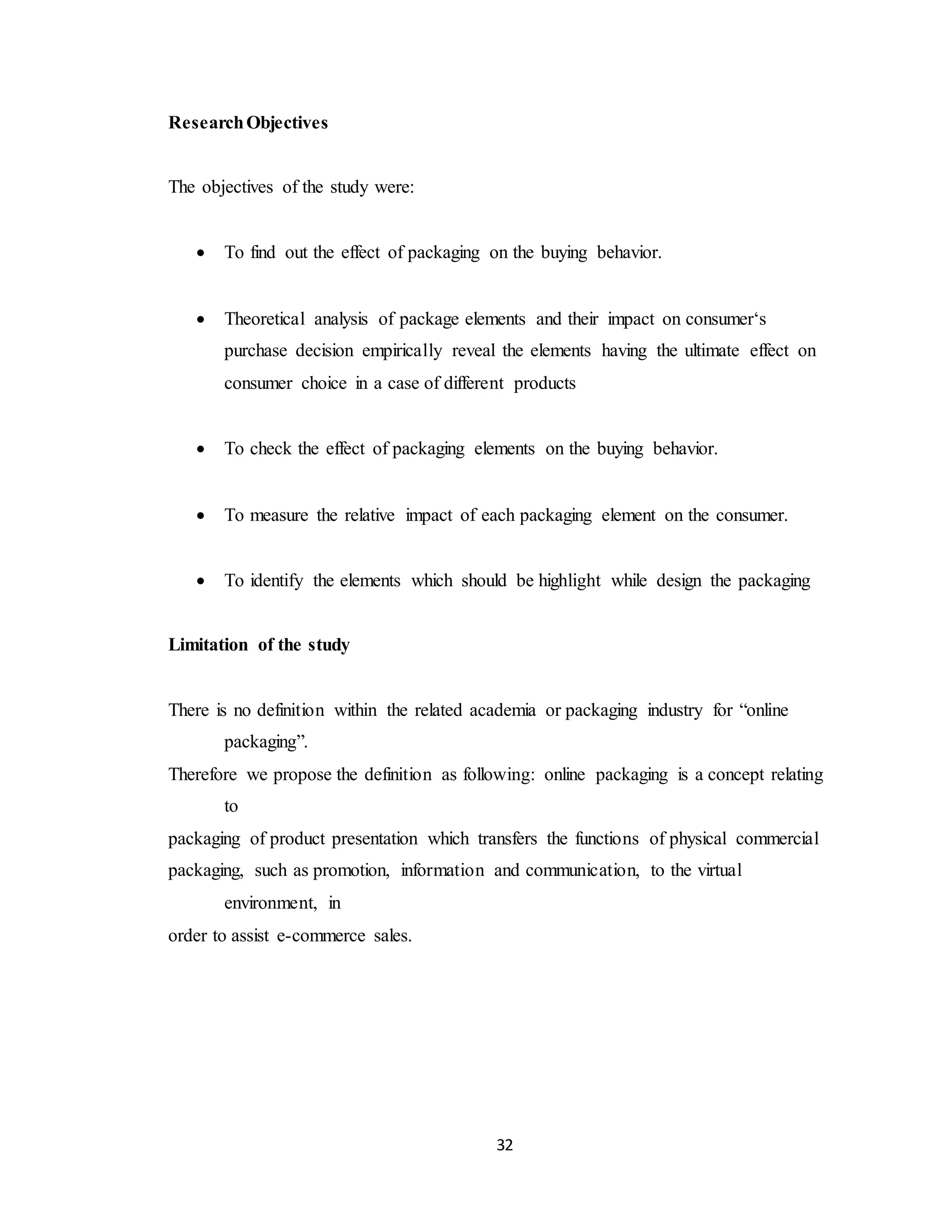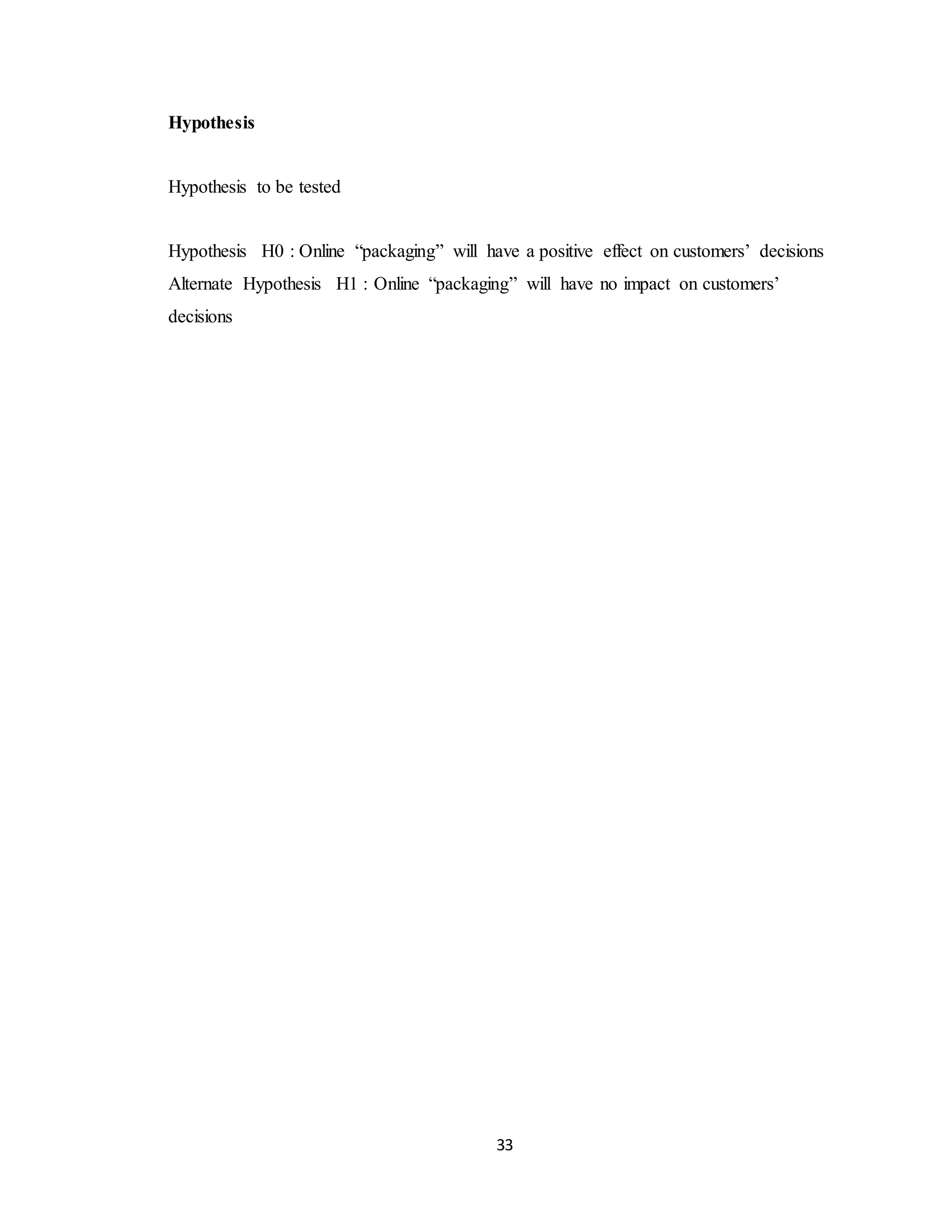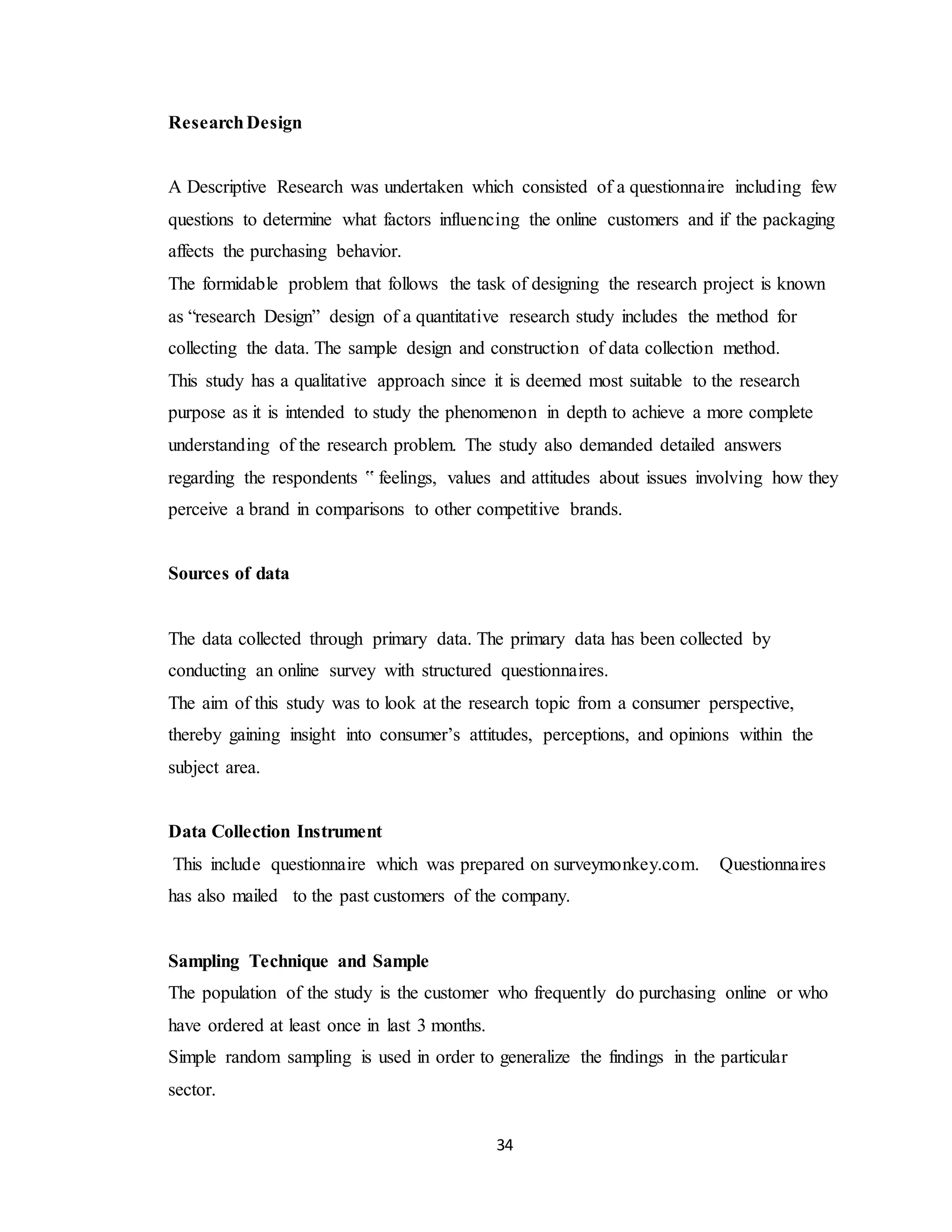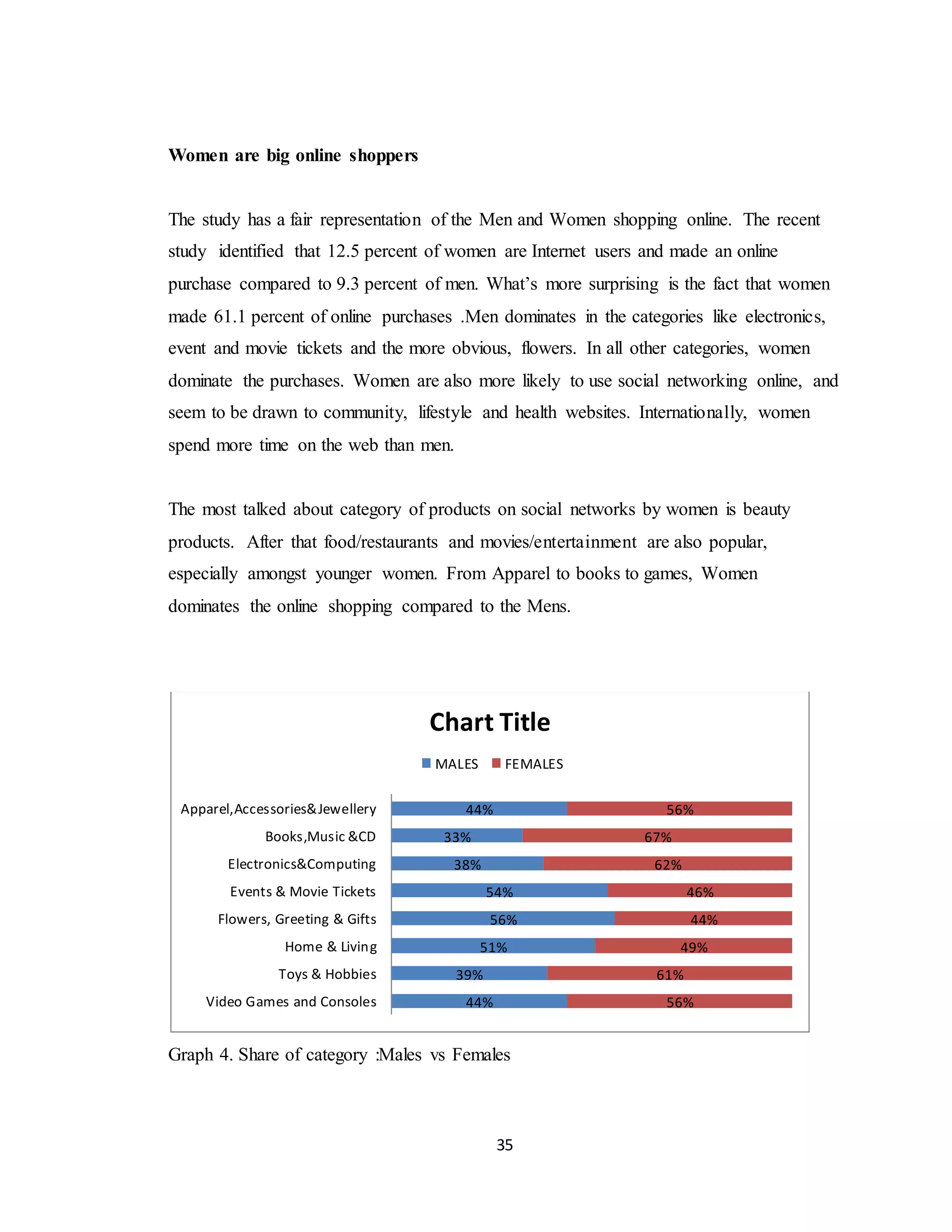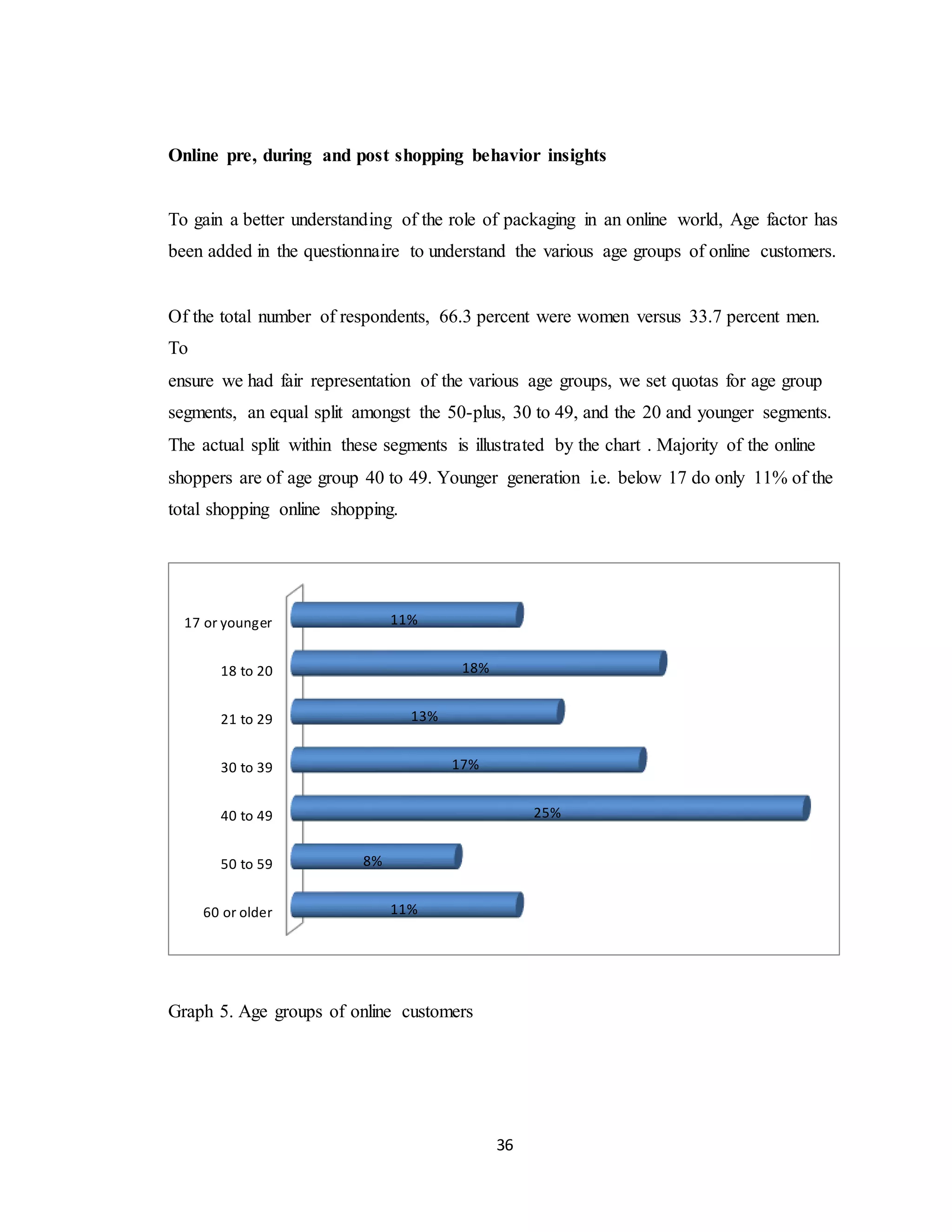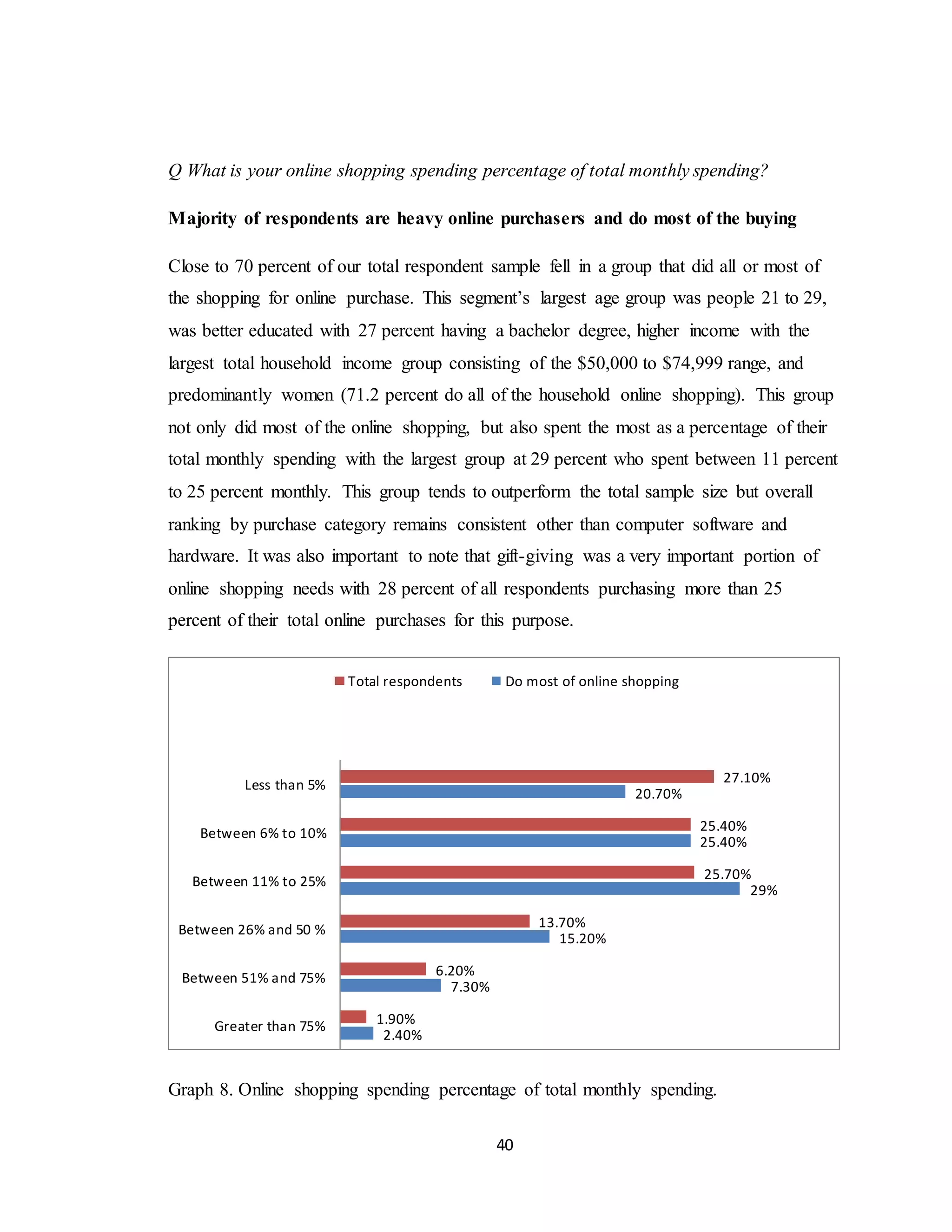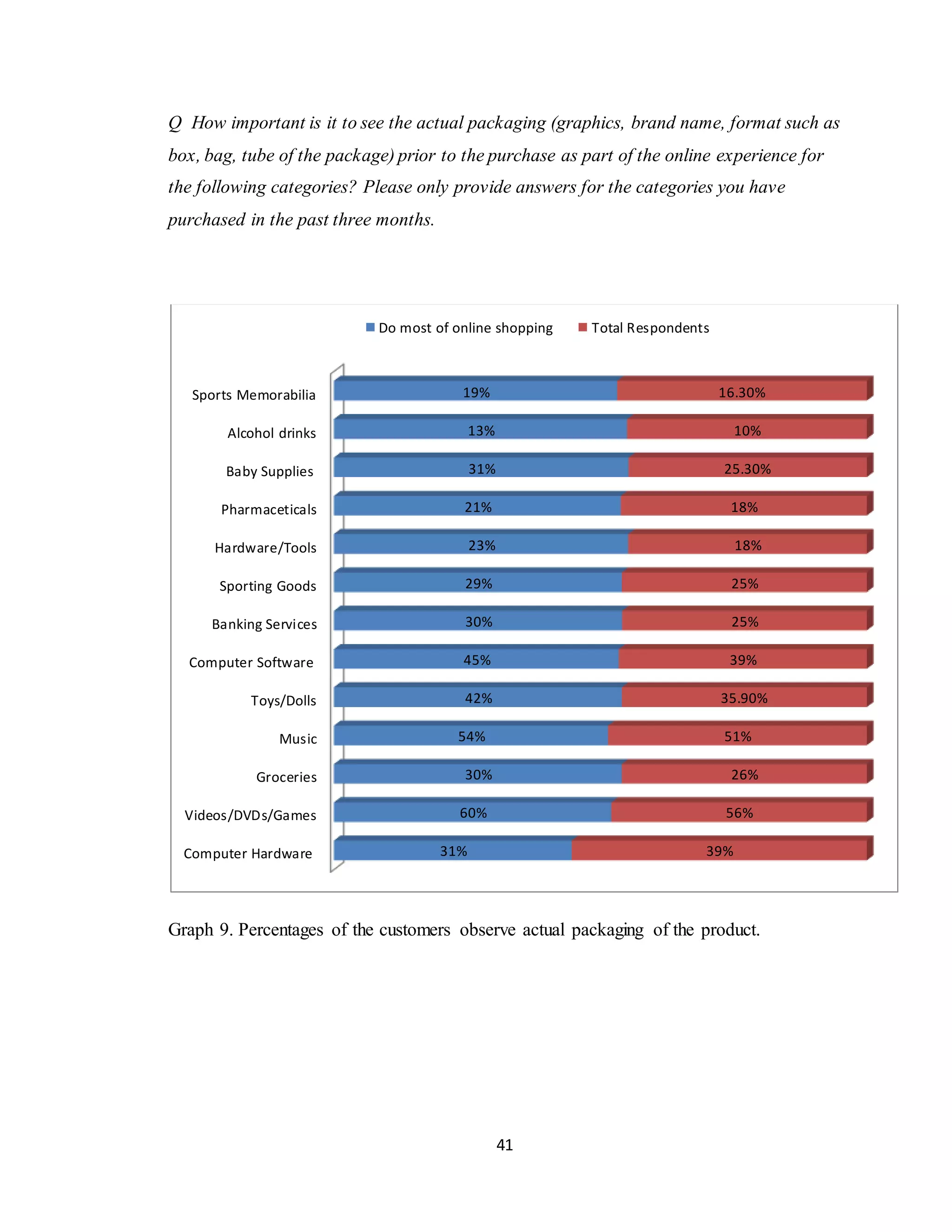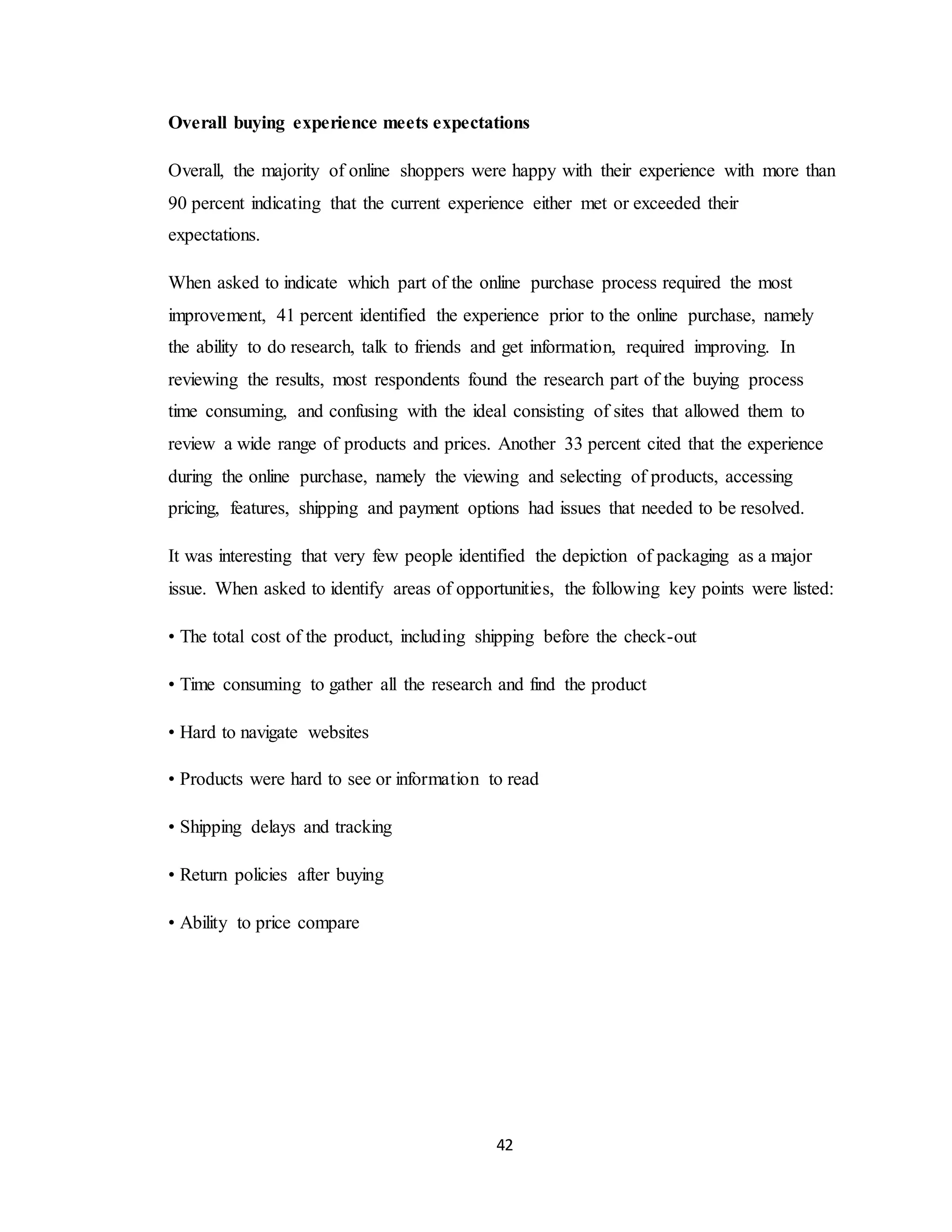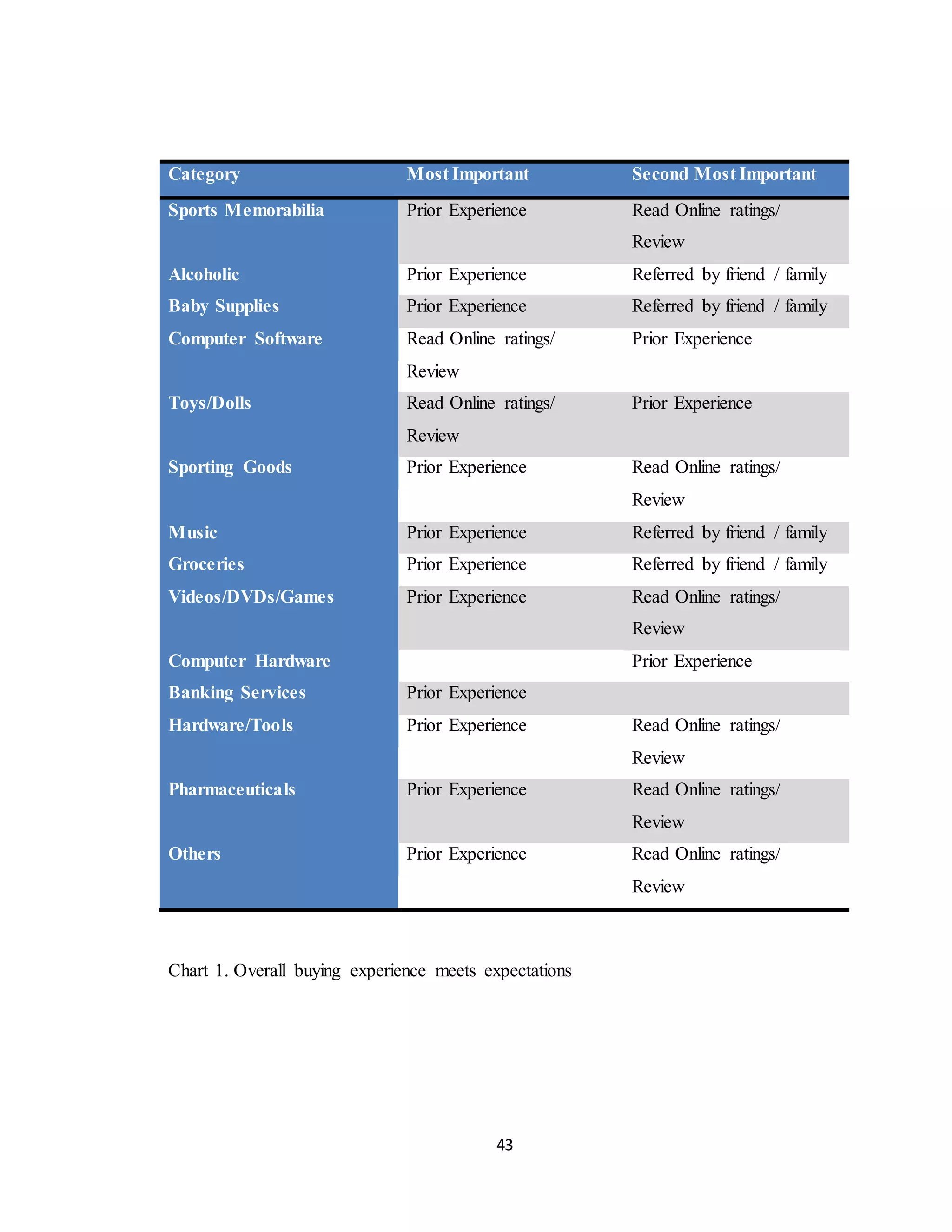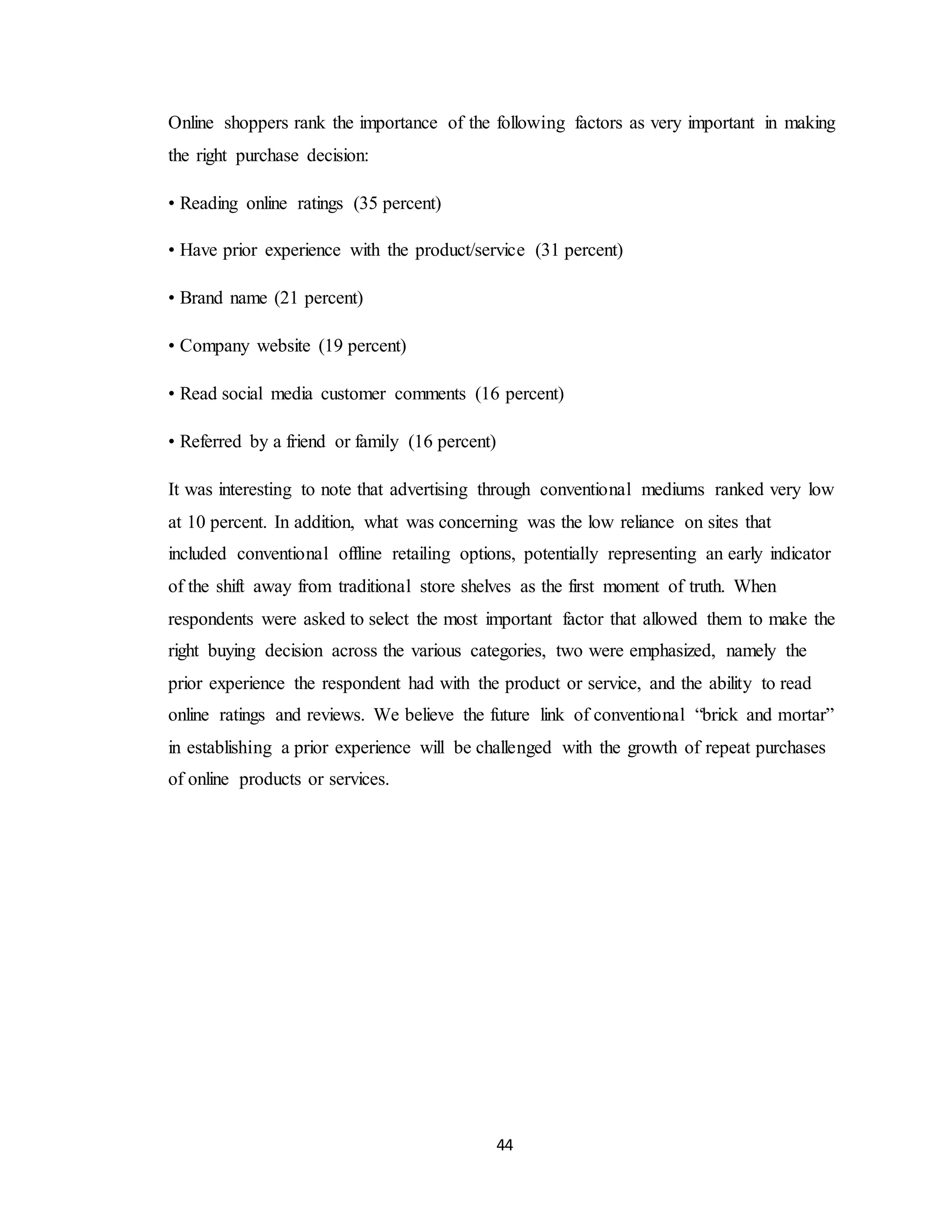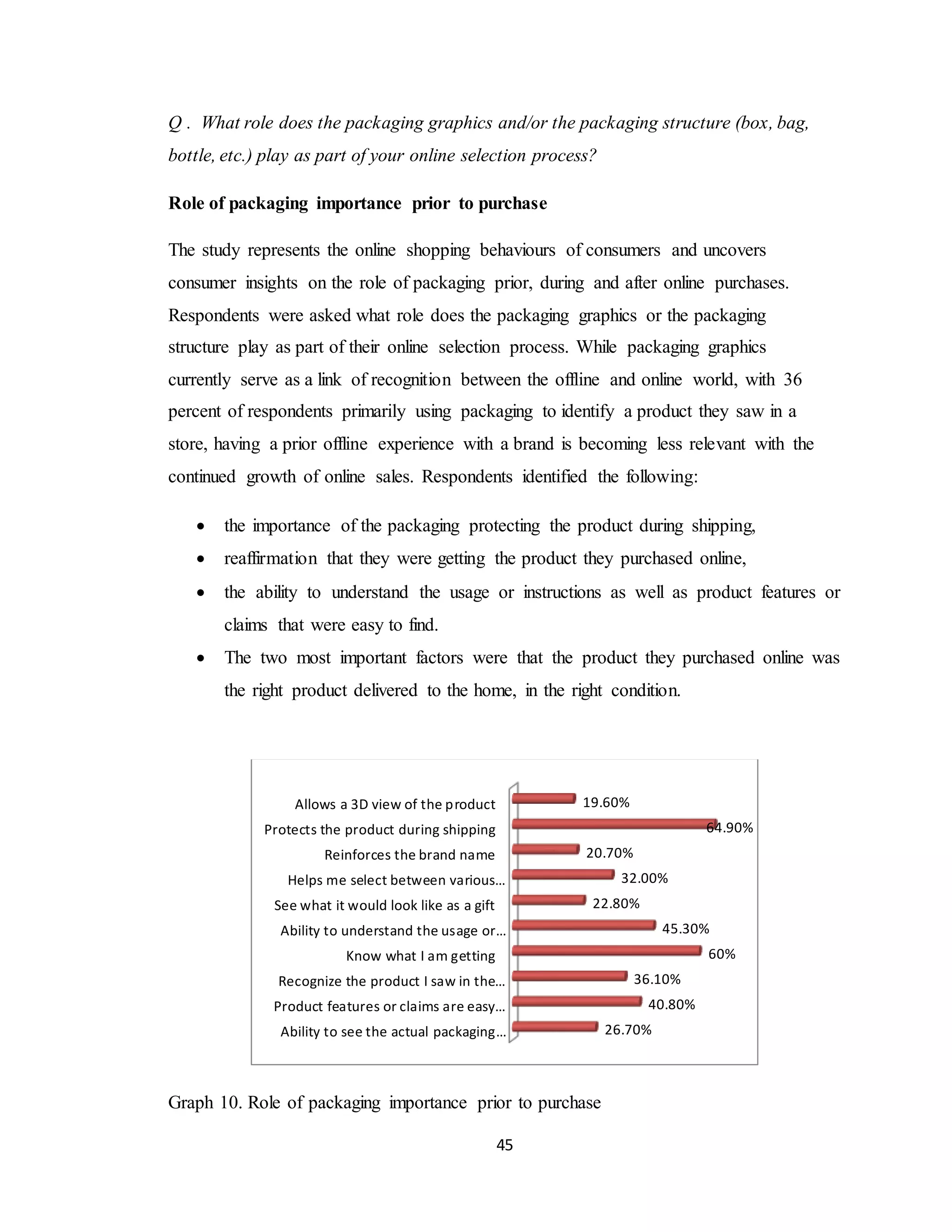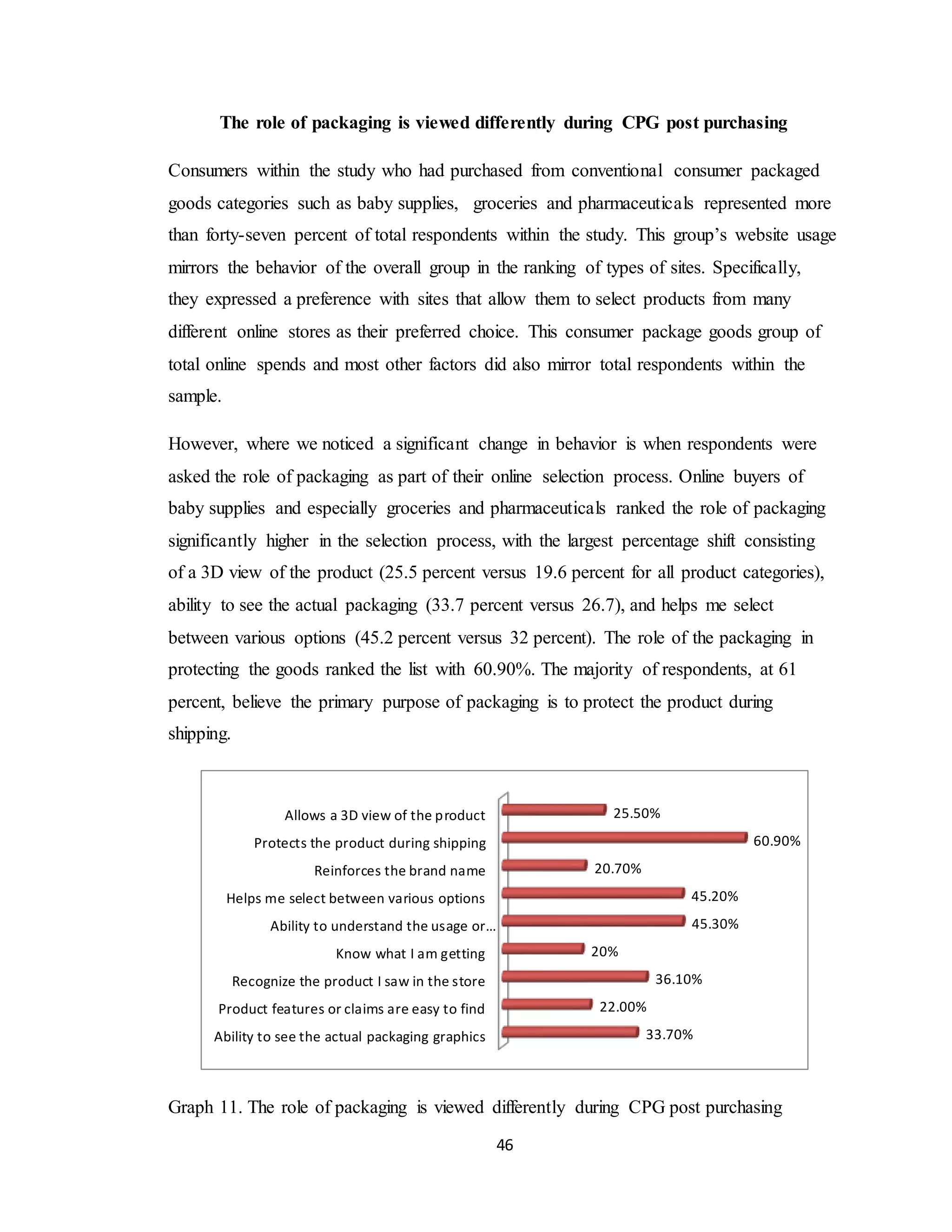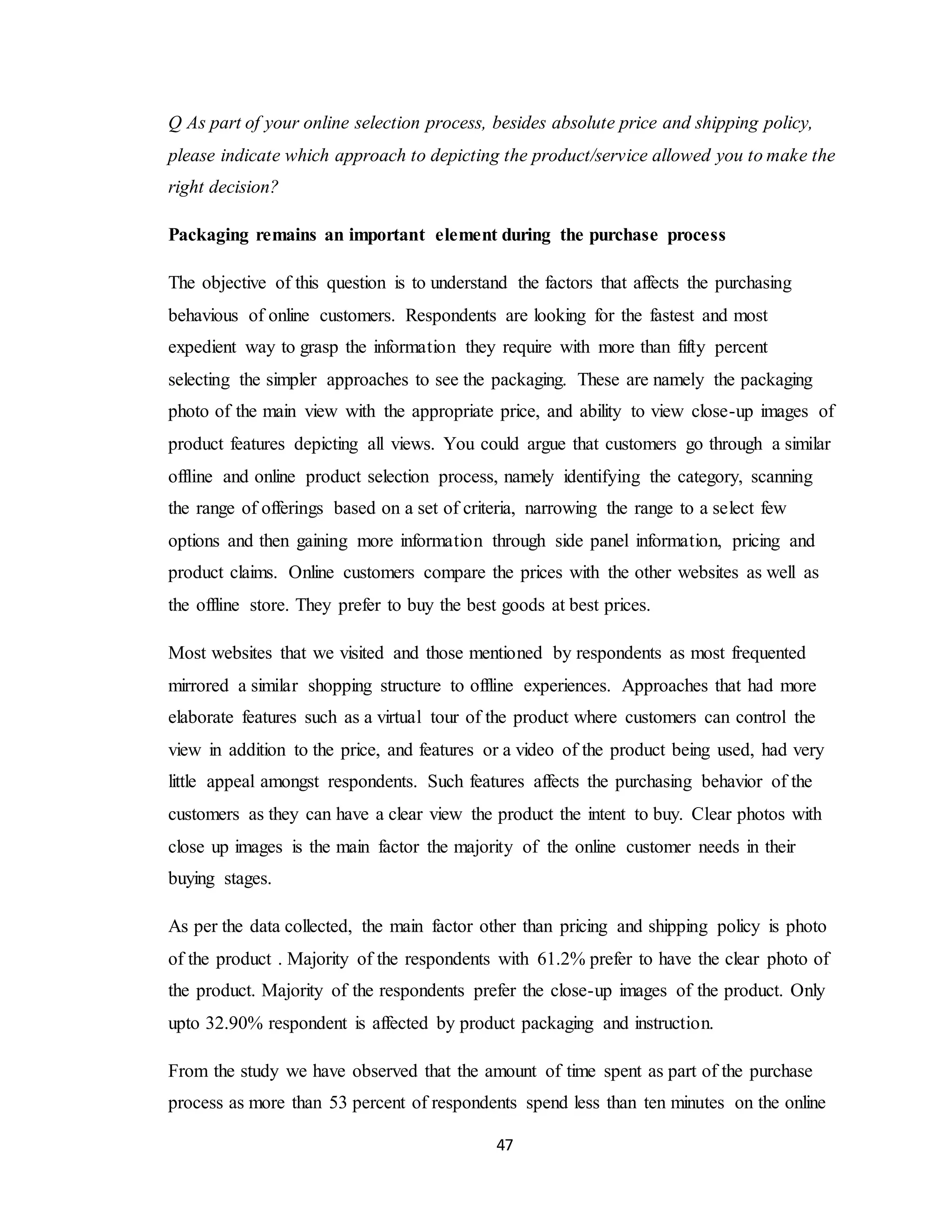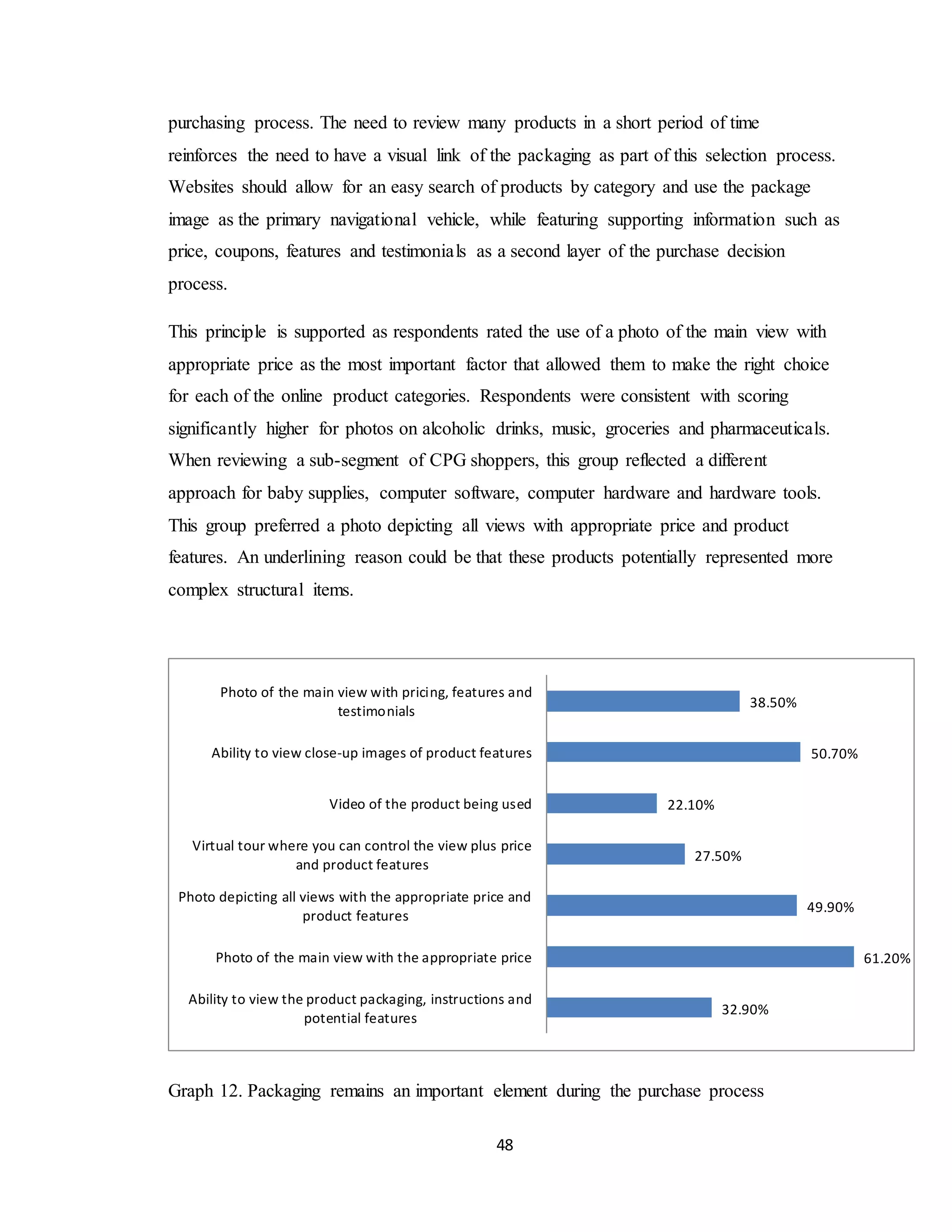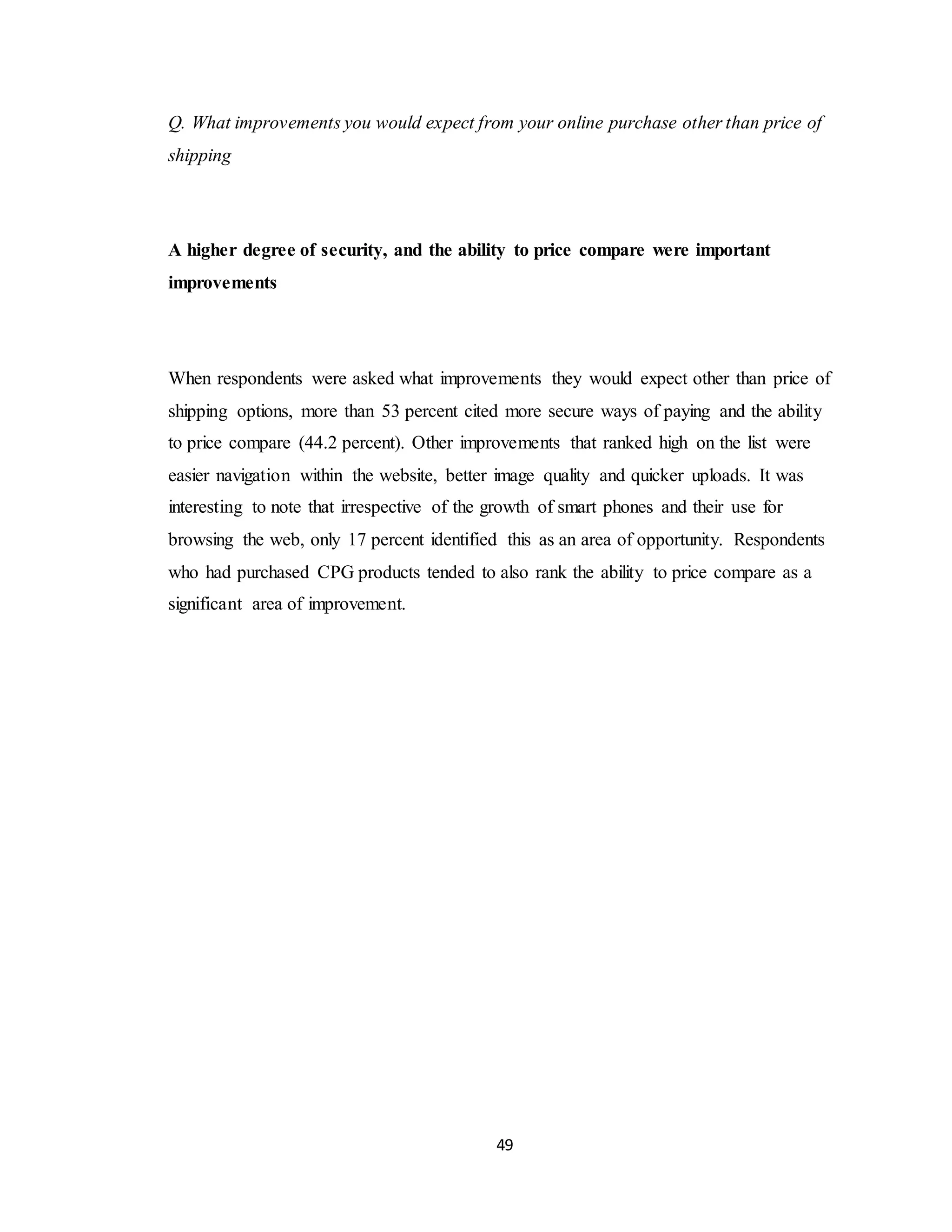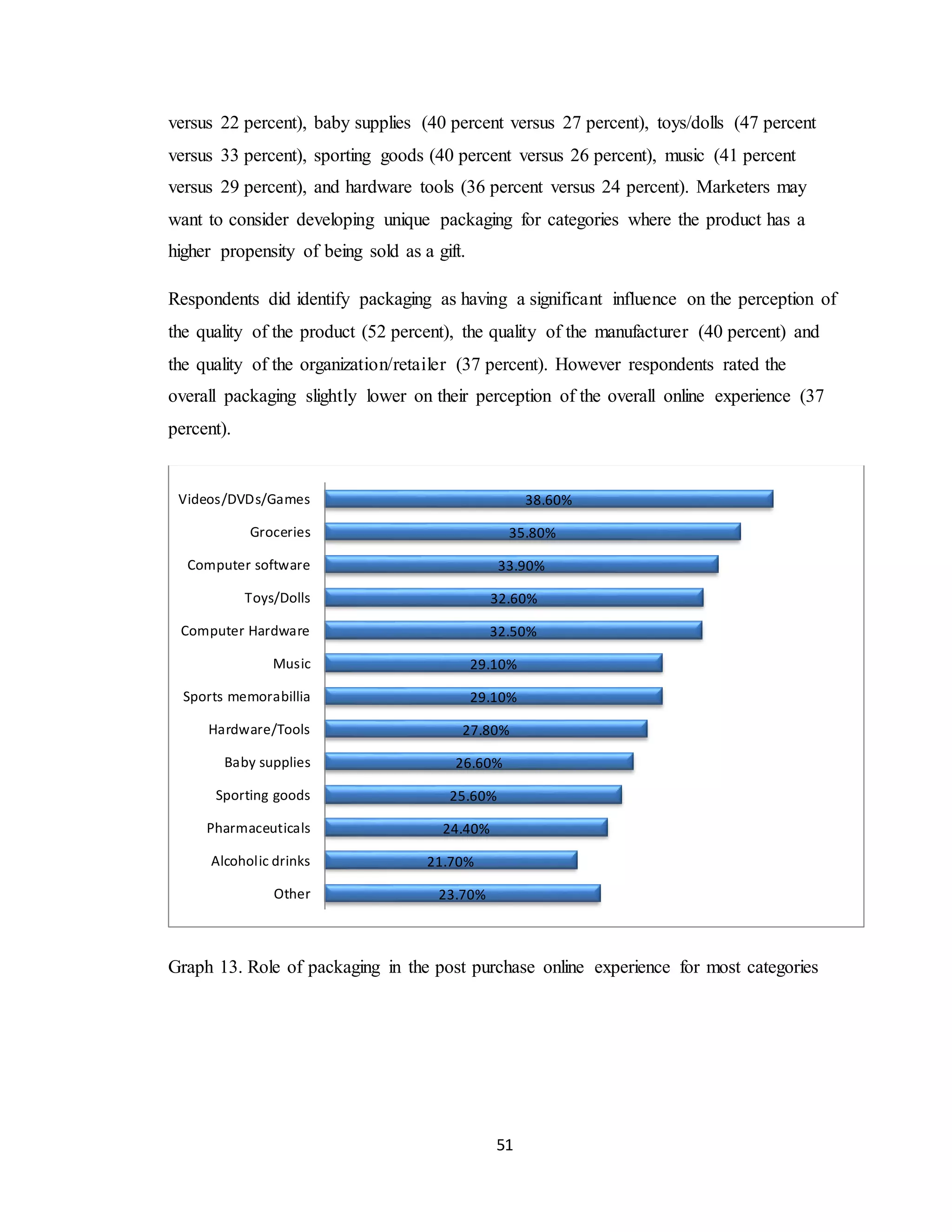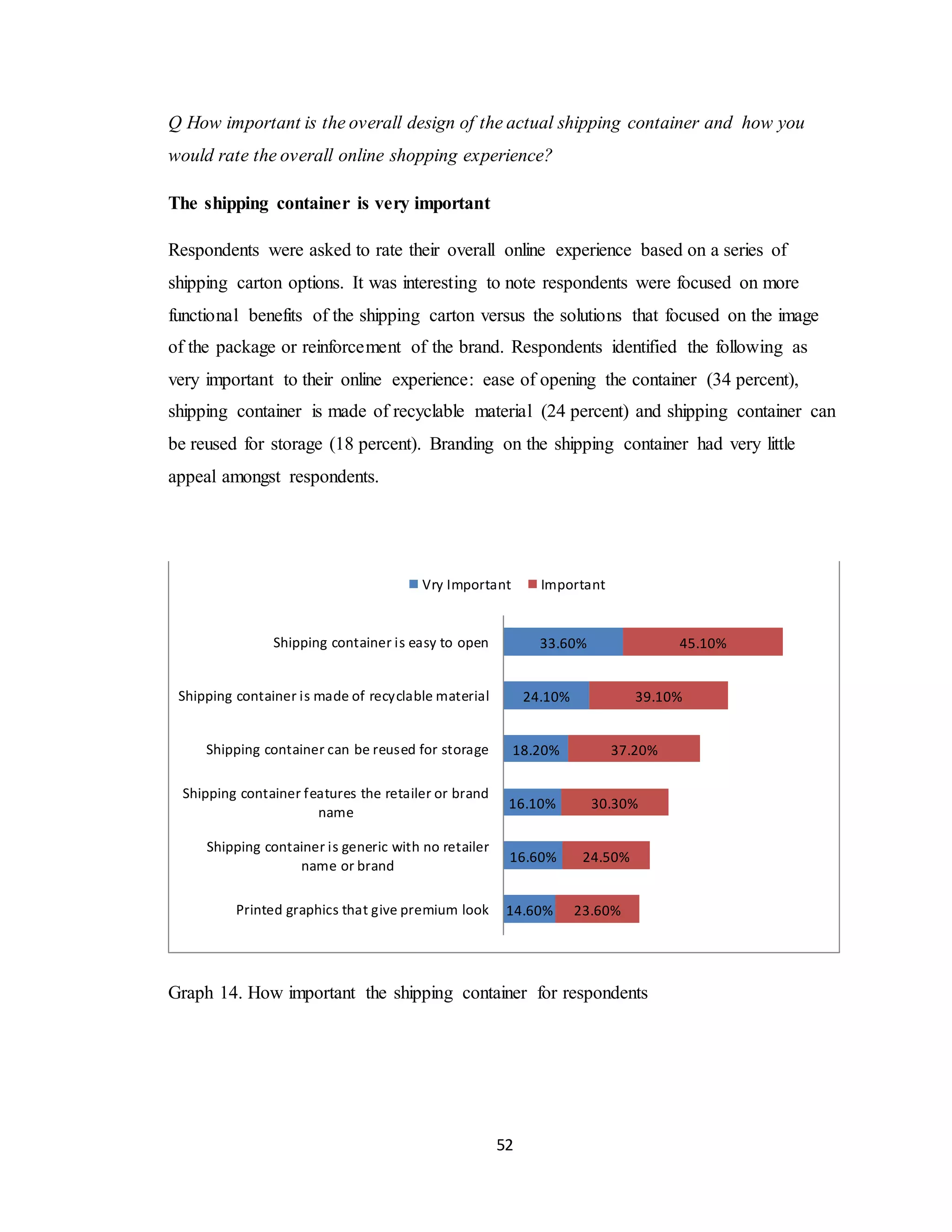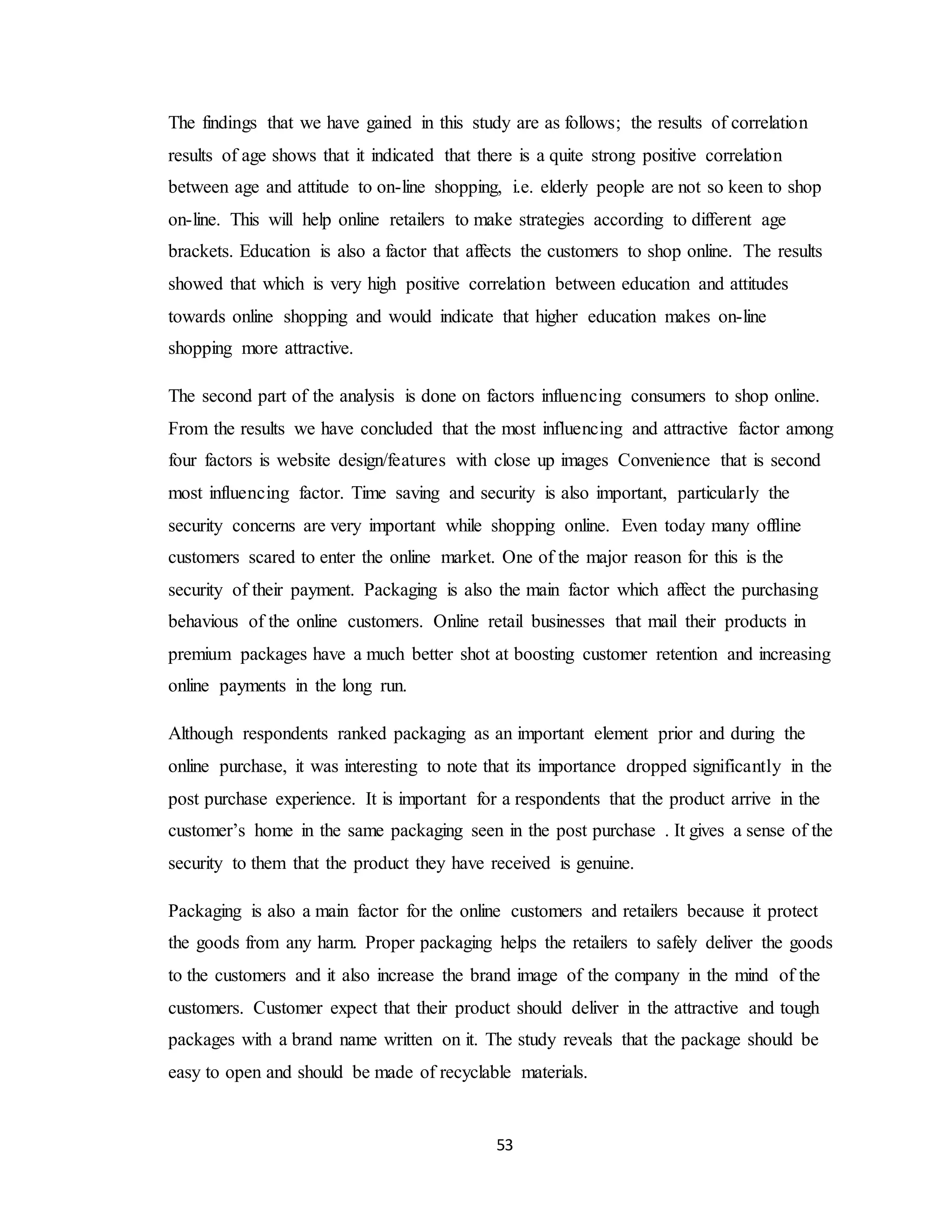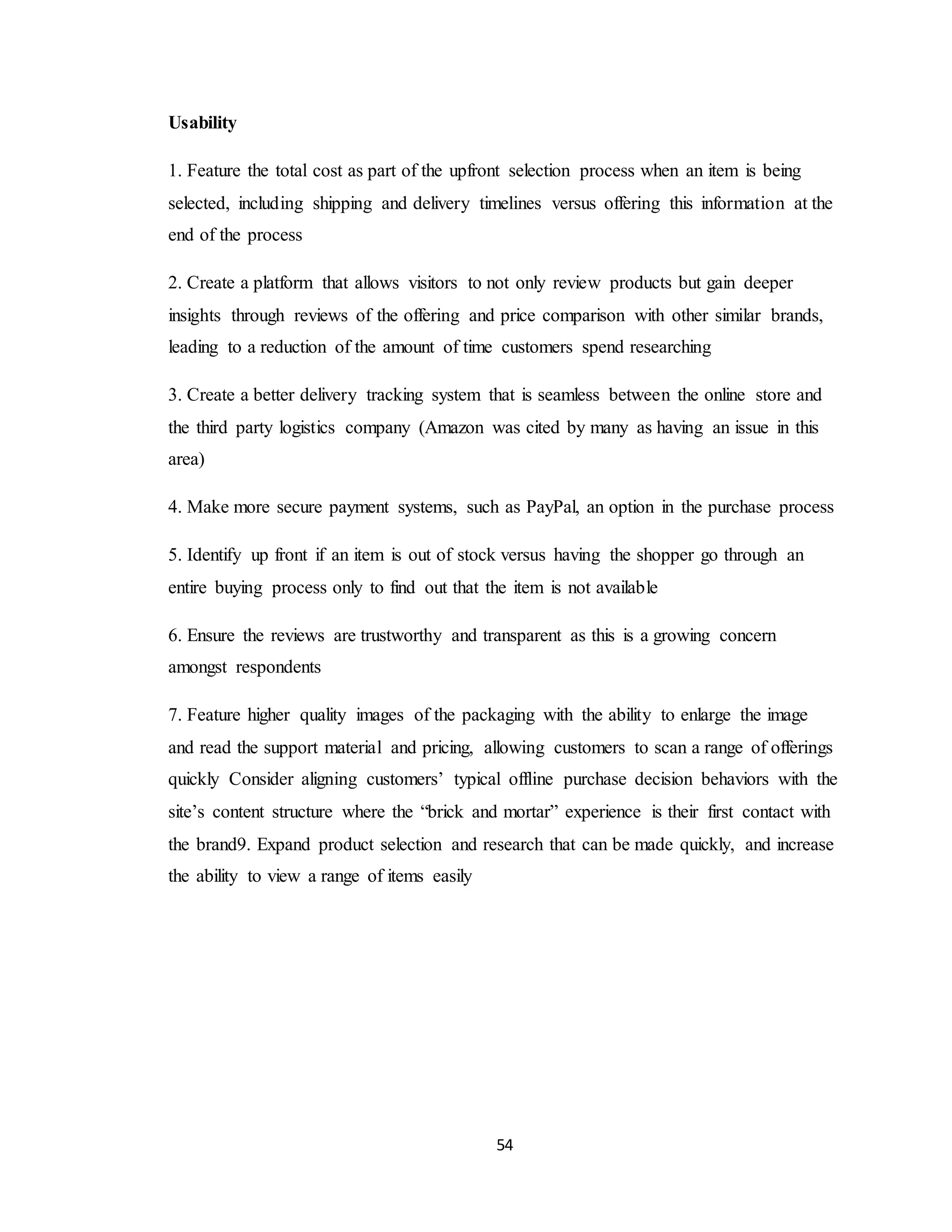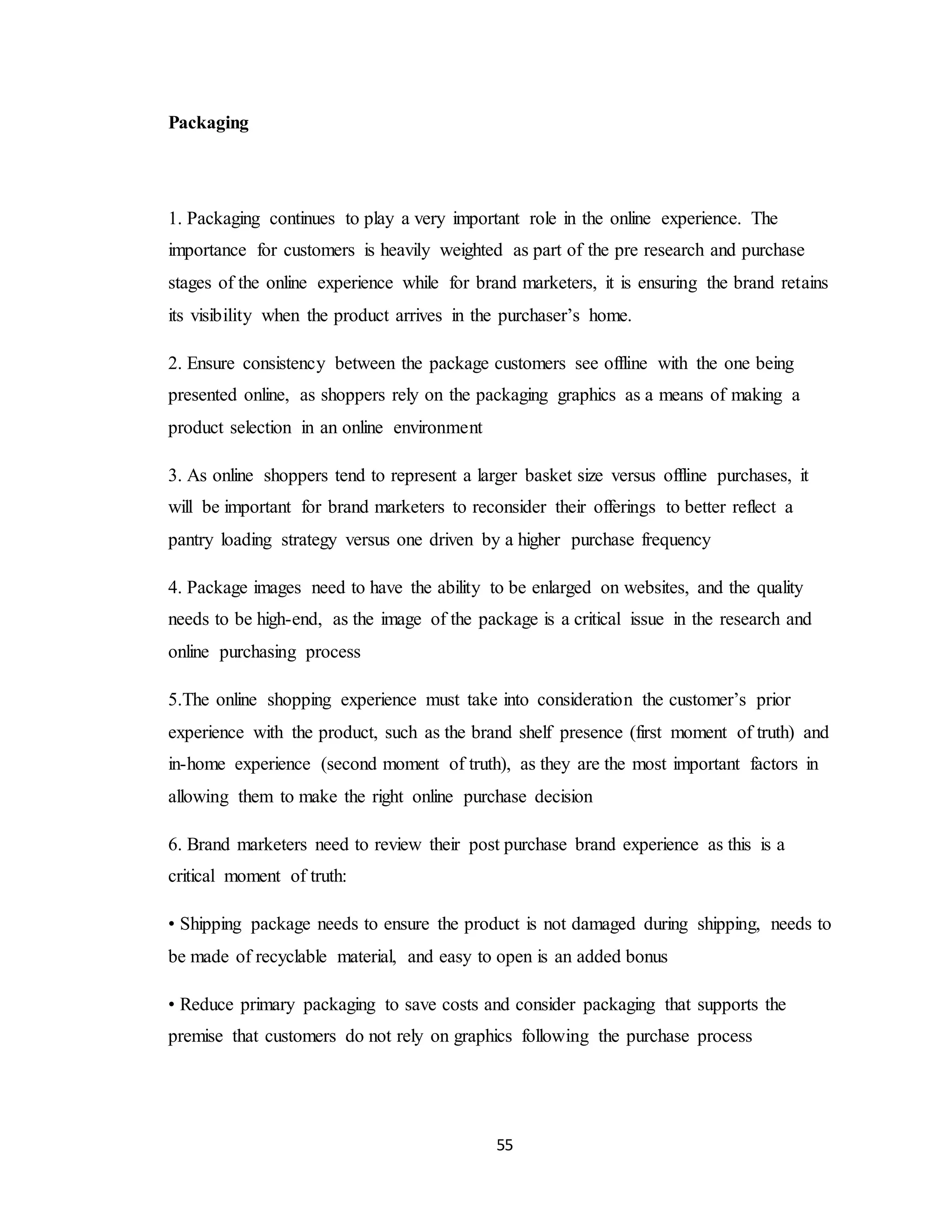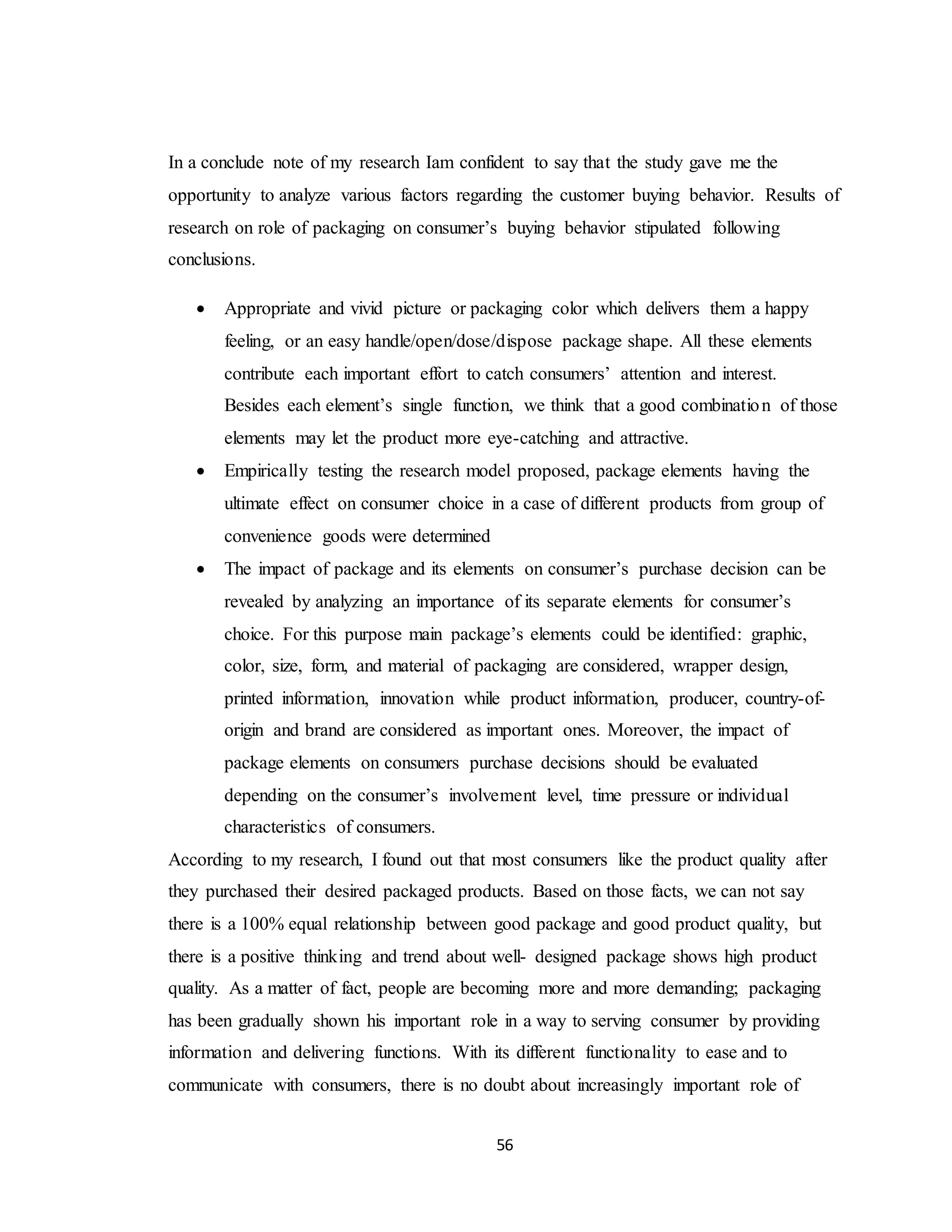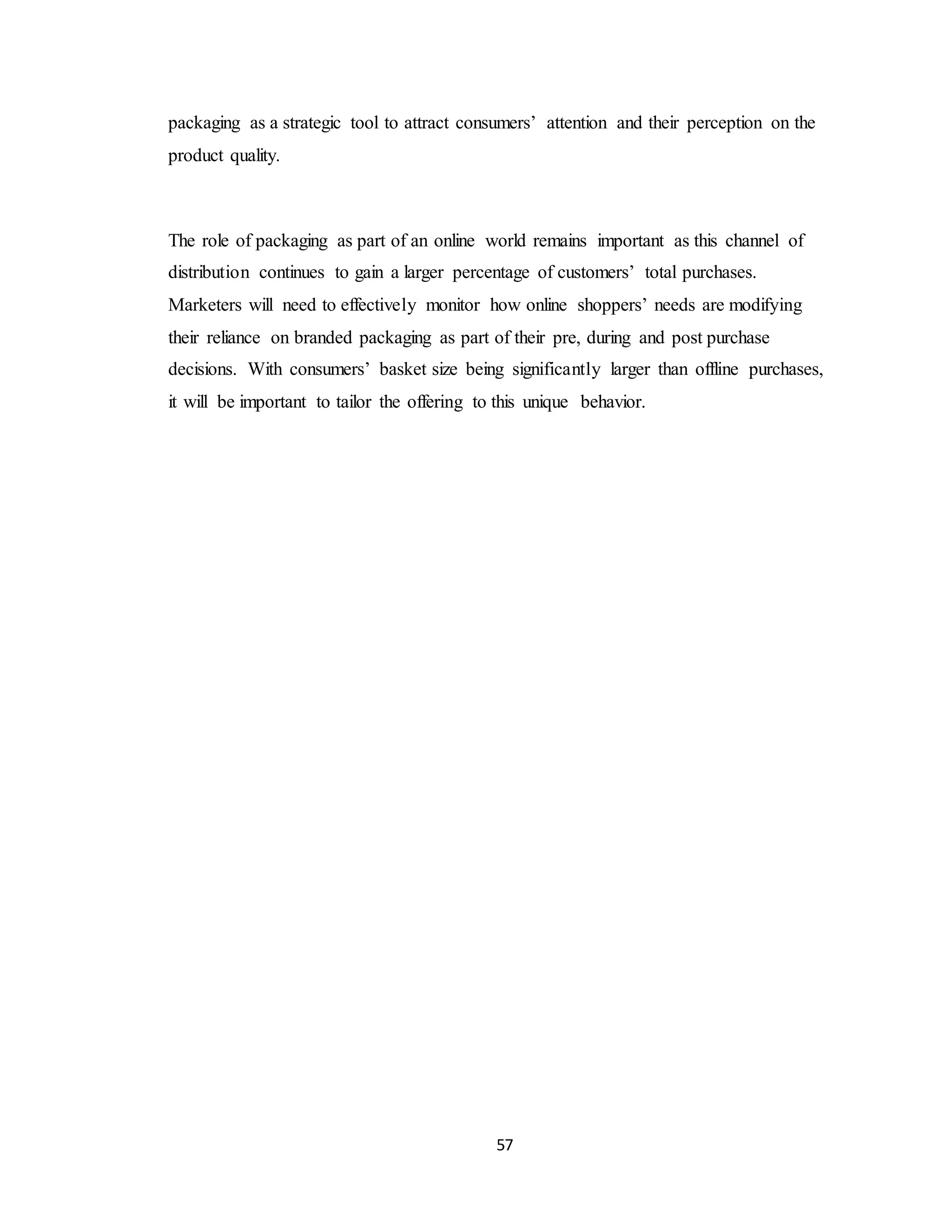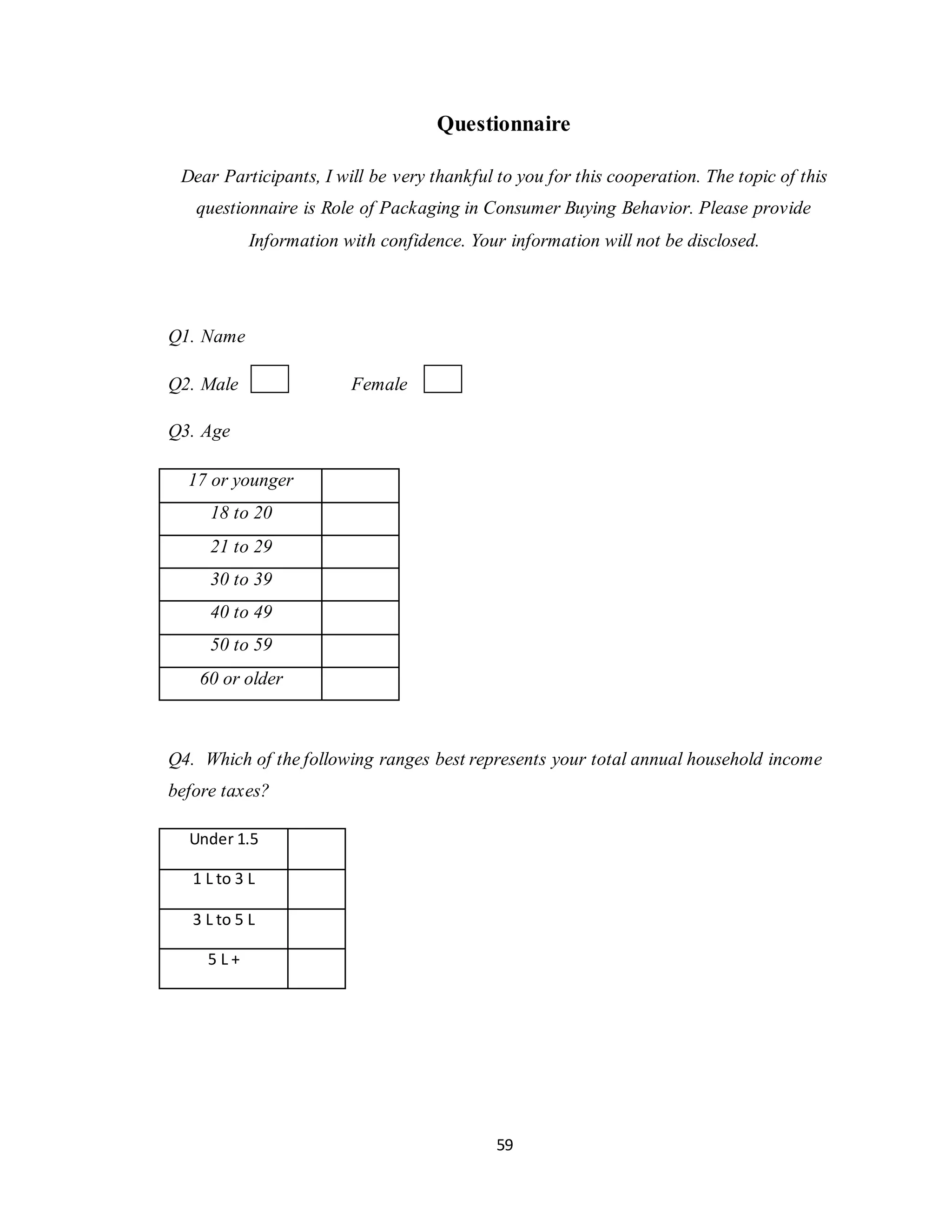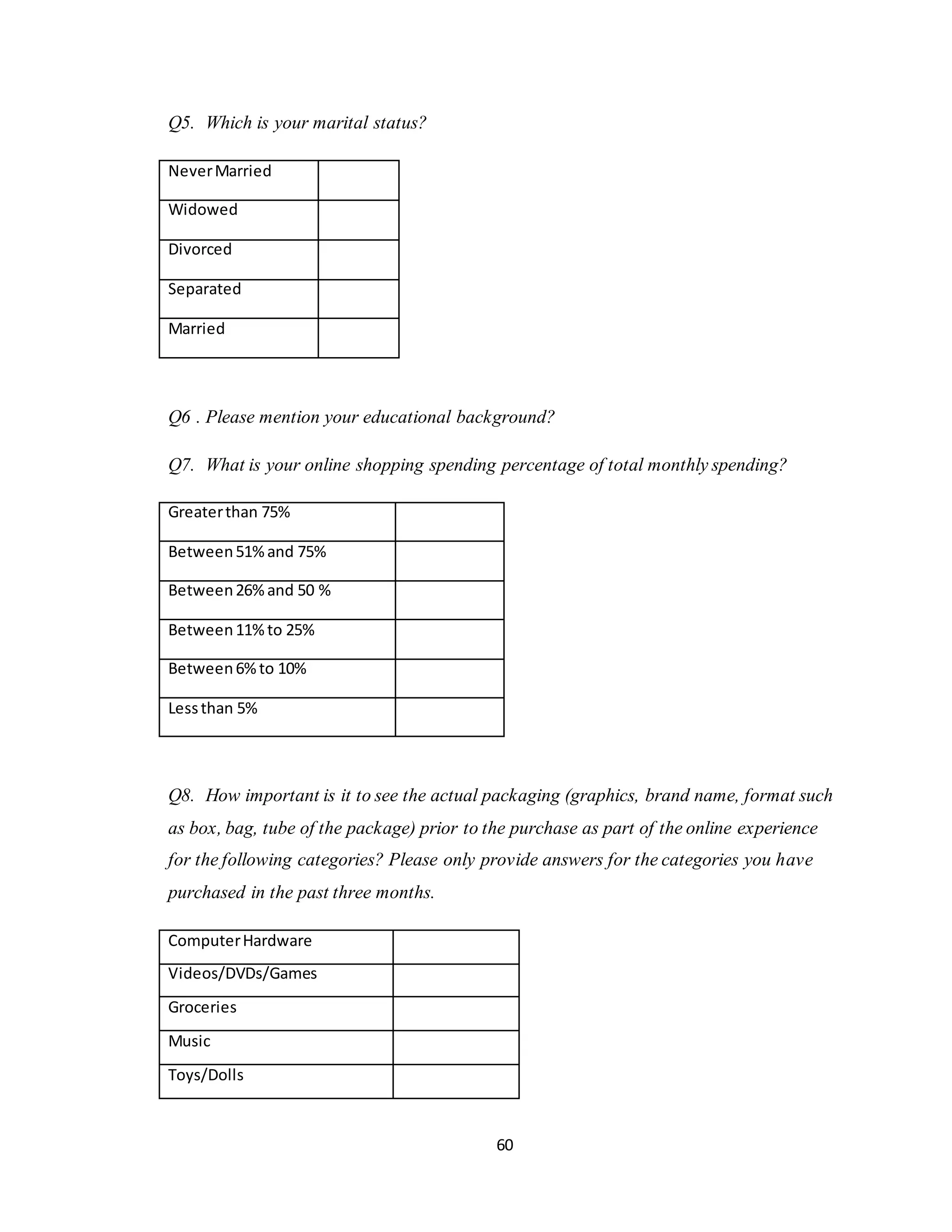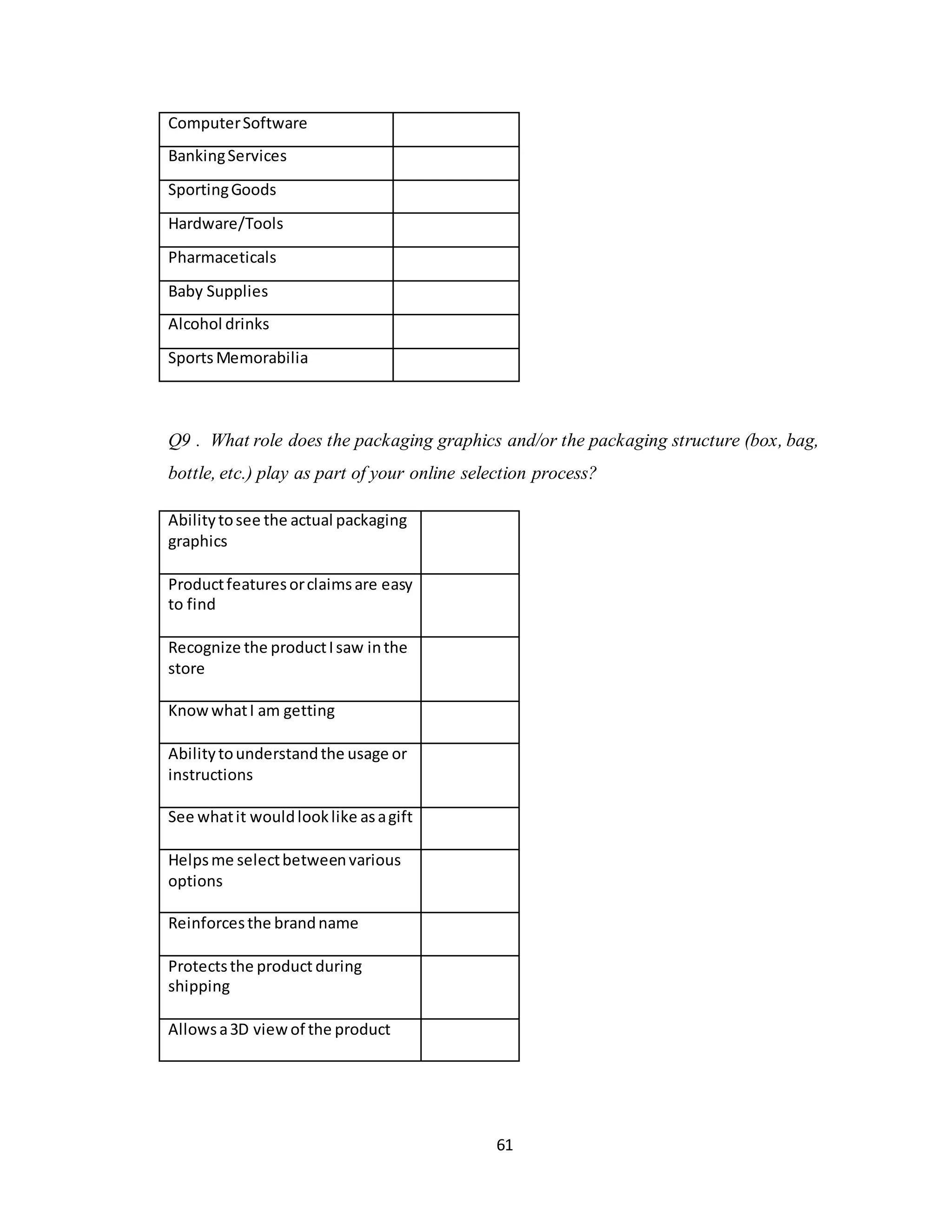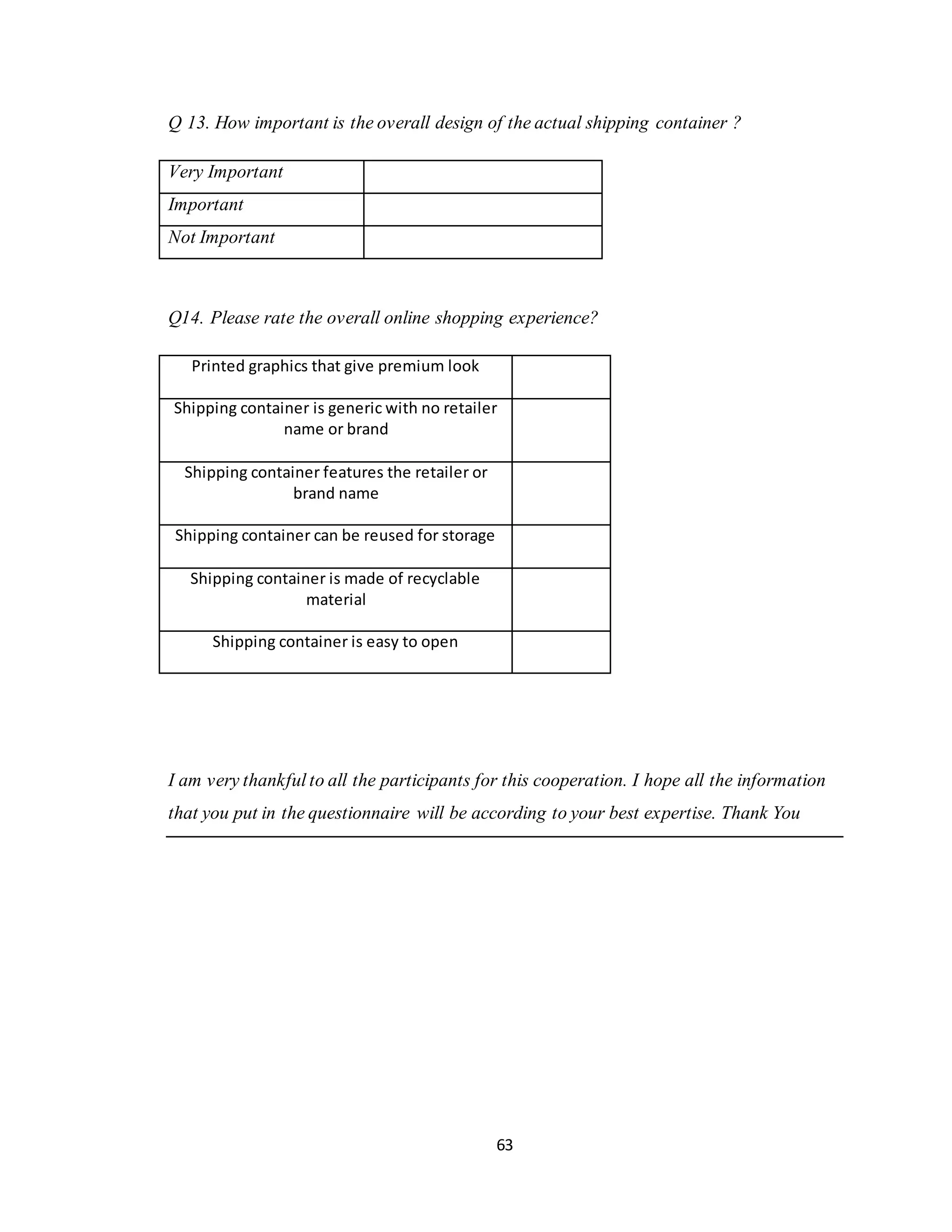The document discusses the role of packaging in online shopping. It notes that while packaging plays an important role in protecting products and communicating brands in physical stores, its role changes in online shopping where the primary purpose after purchase is protection during shipping. However, packaging still influences consumer behavior and loyalty online. Marketers are exploring opportunities to enhance the online shopping experience through packaging, such as ensuring it matches what was shown online or creating memorable unboxing experiences. While packaging may become less important at the point of online purchase, it can boost consumer satisfaction upon delivery.
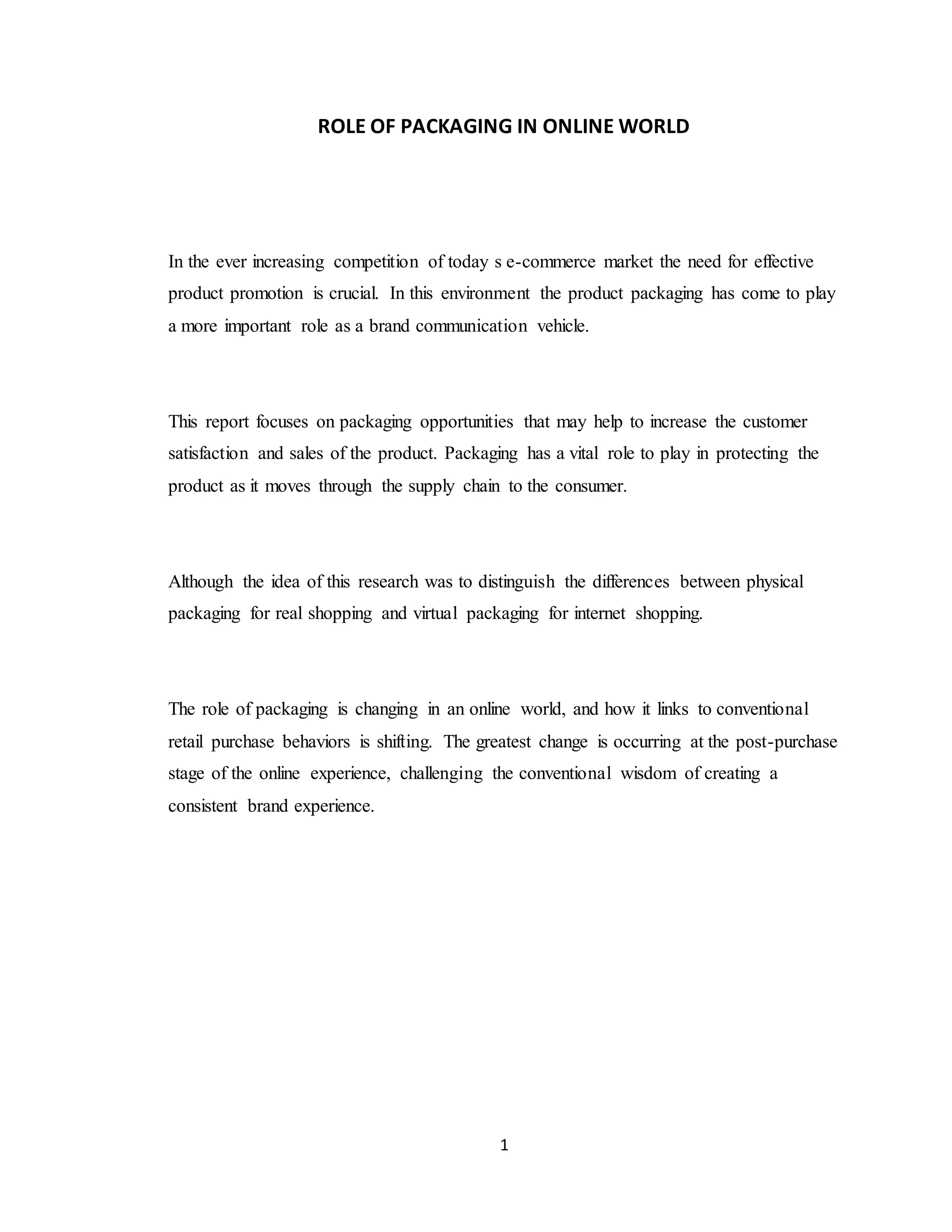
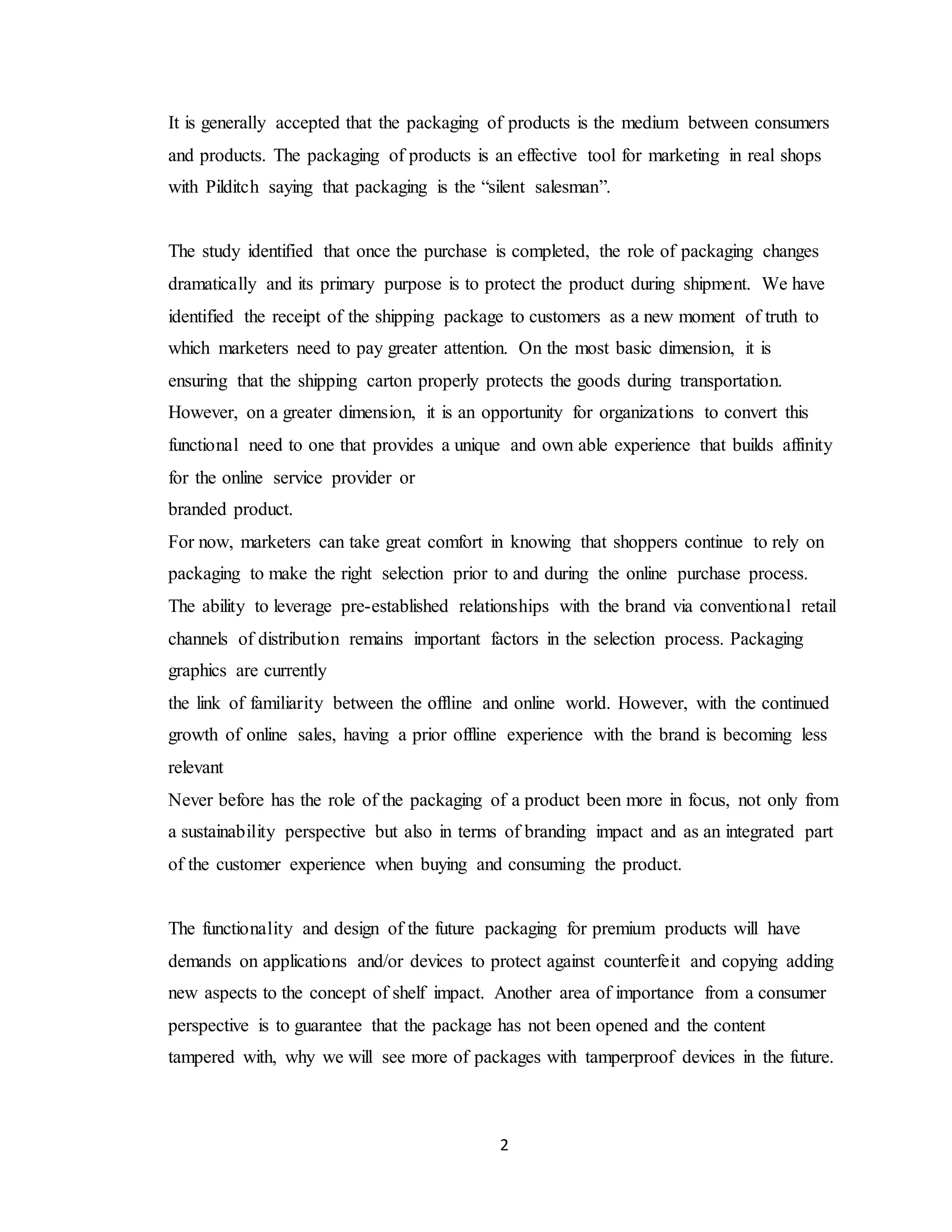
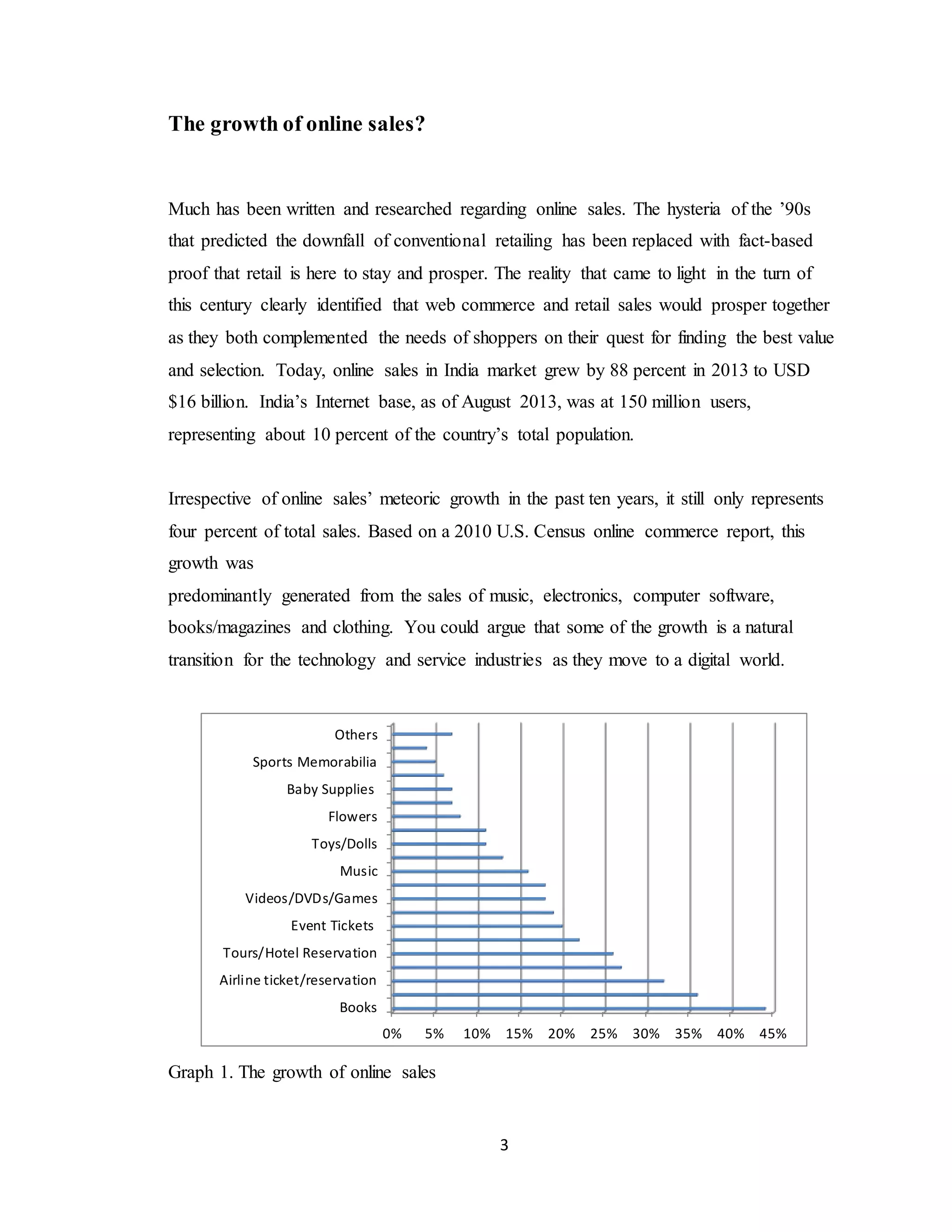
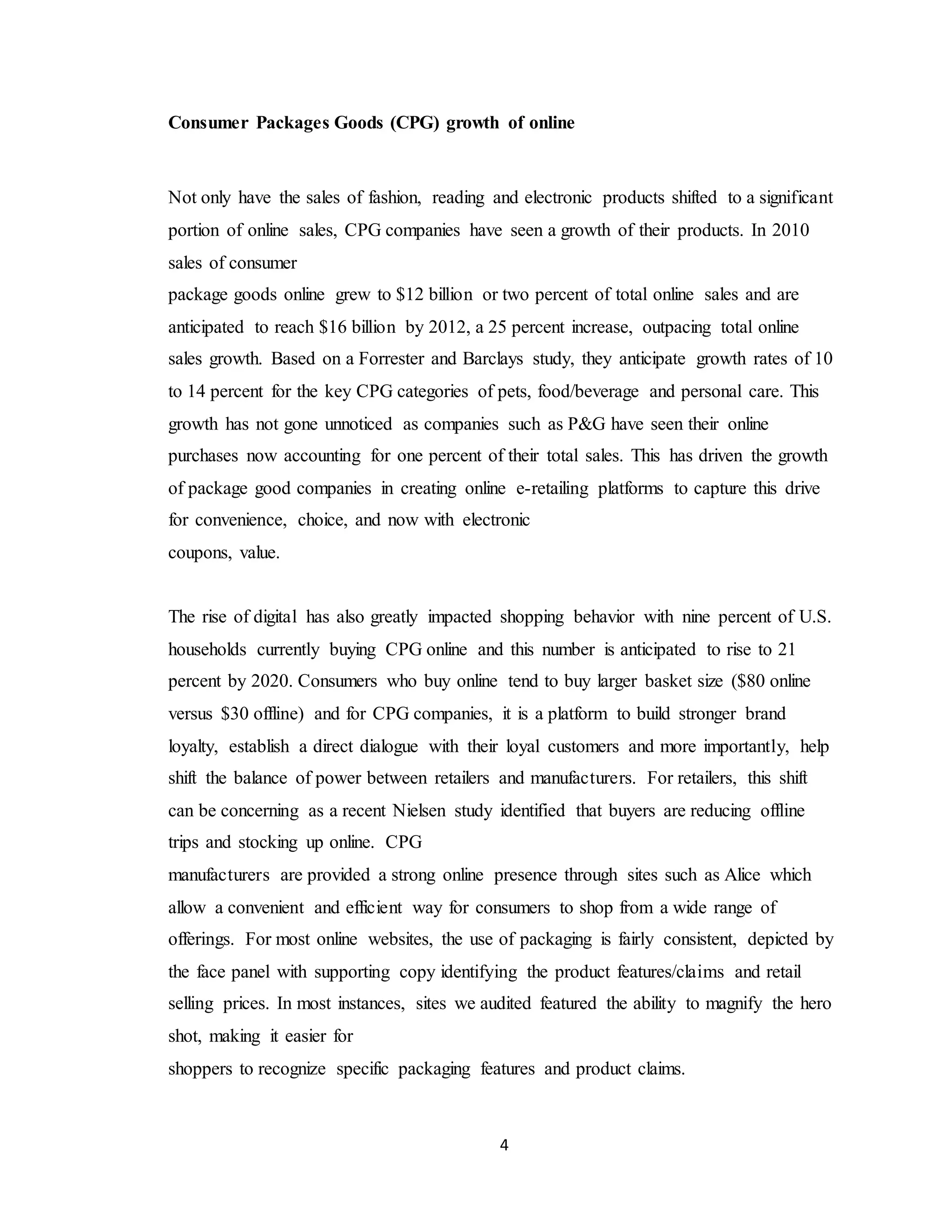
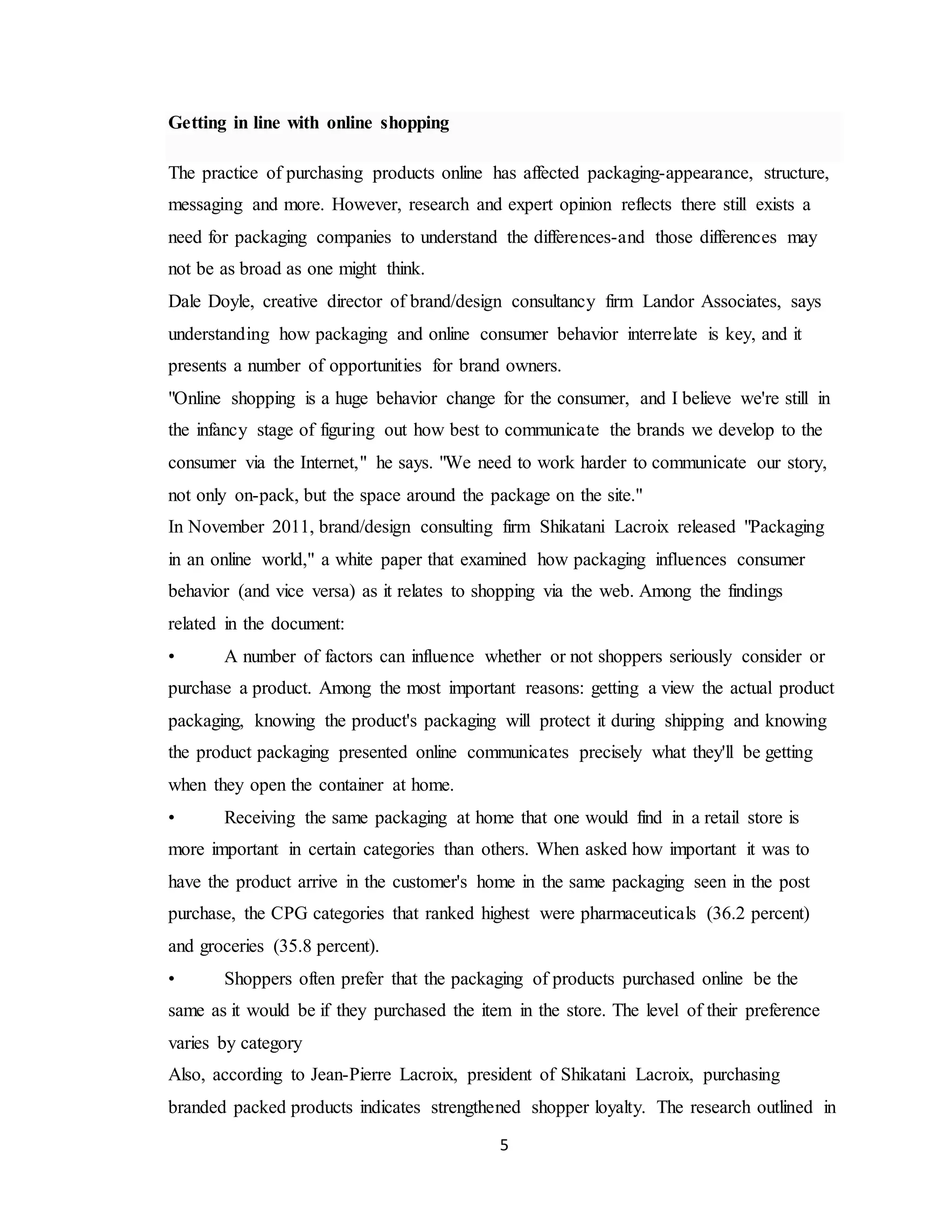
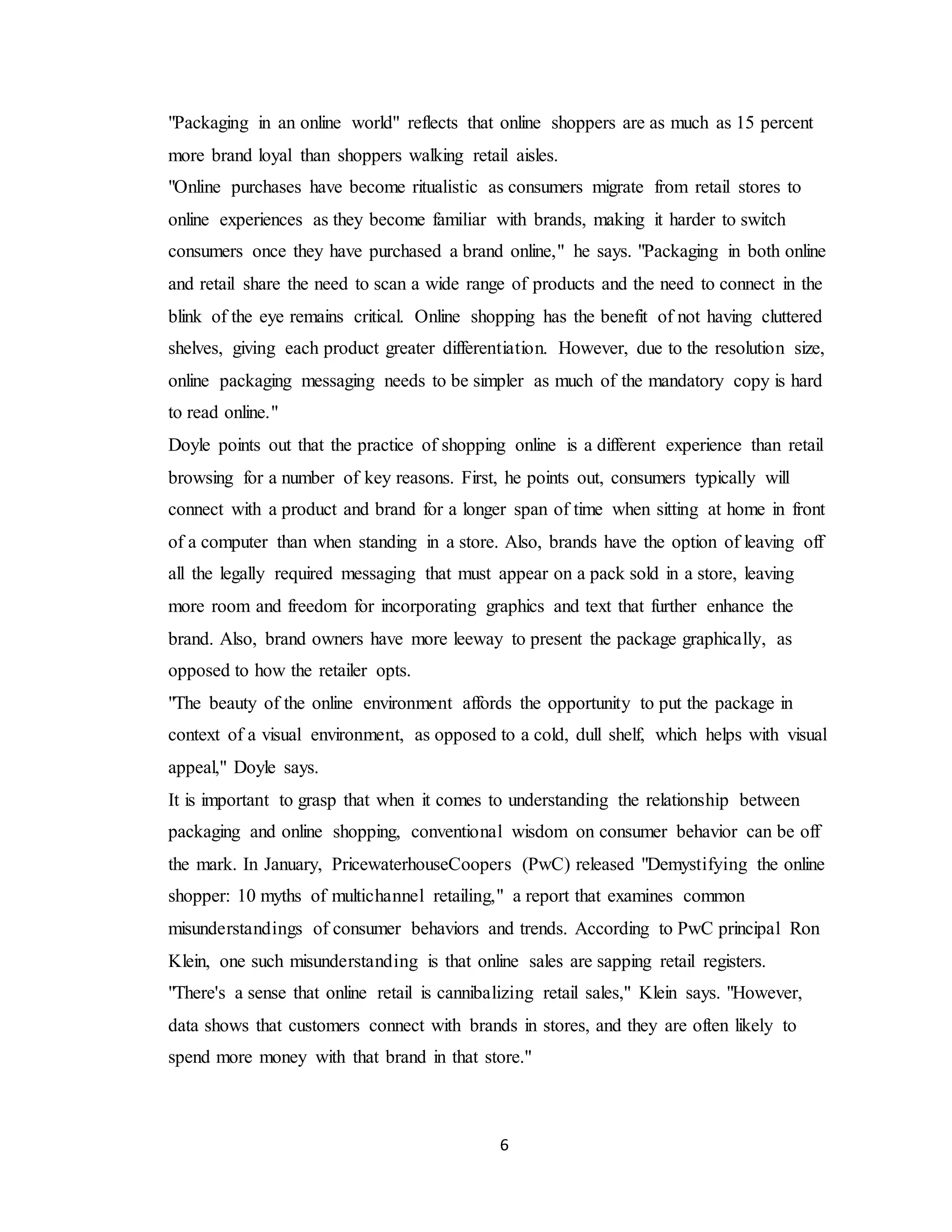
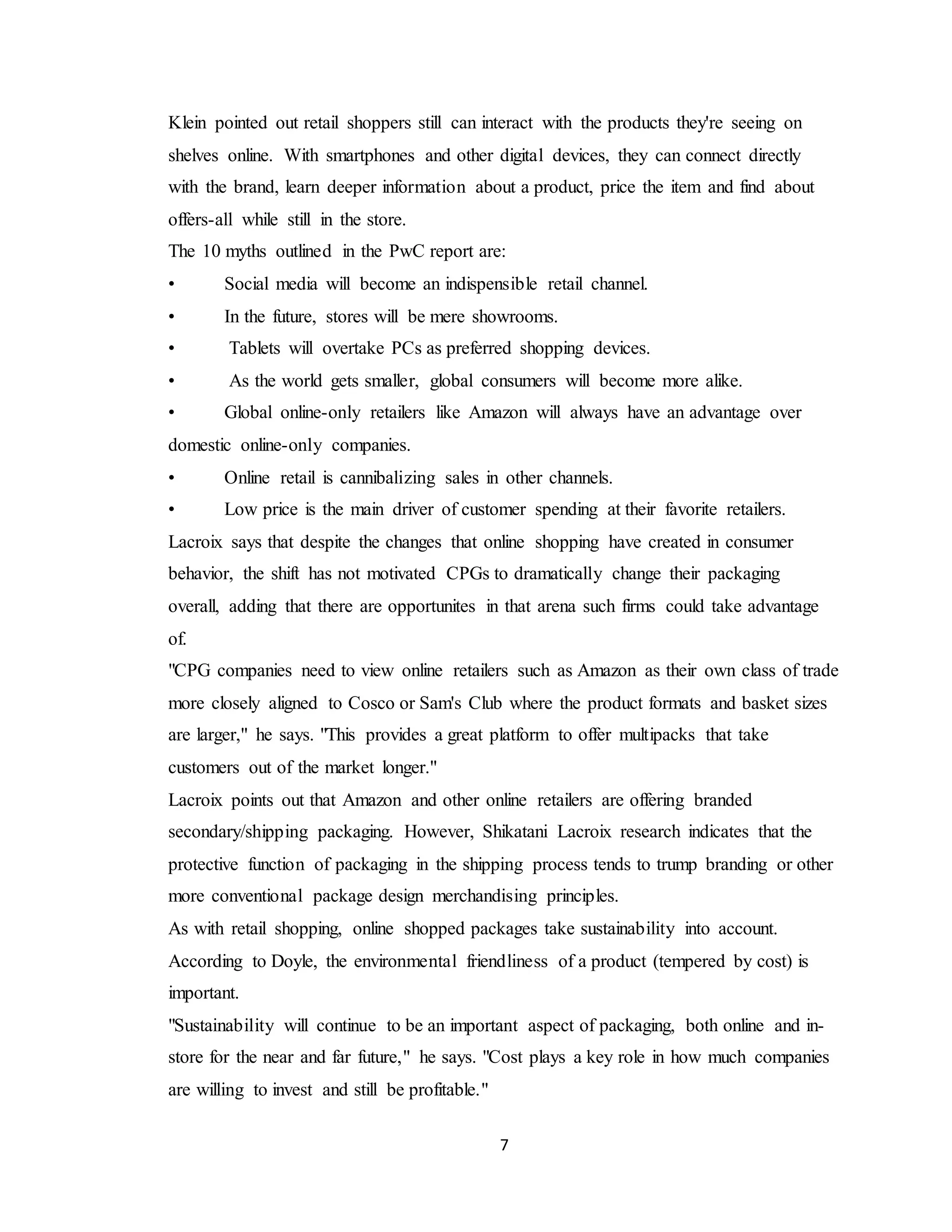
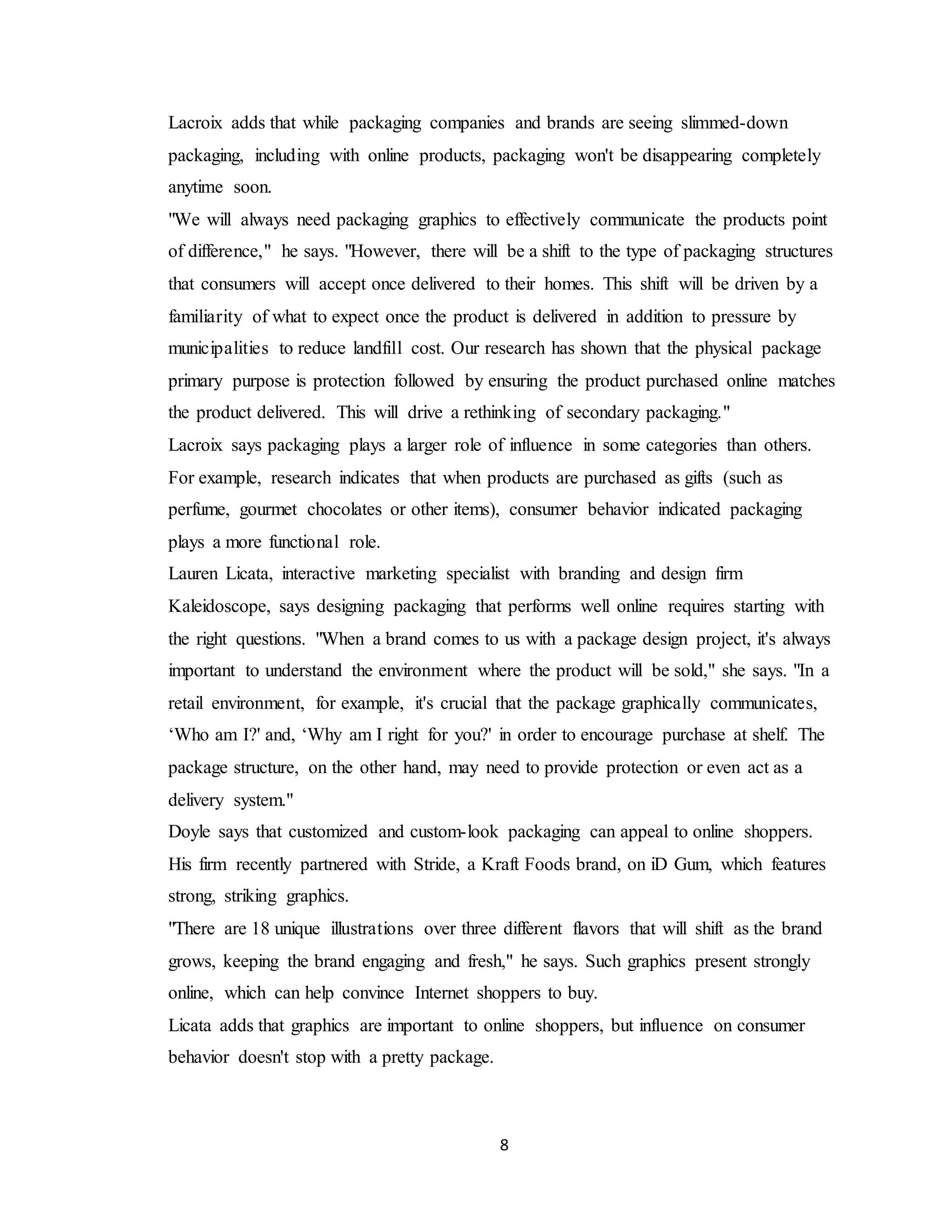
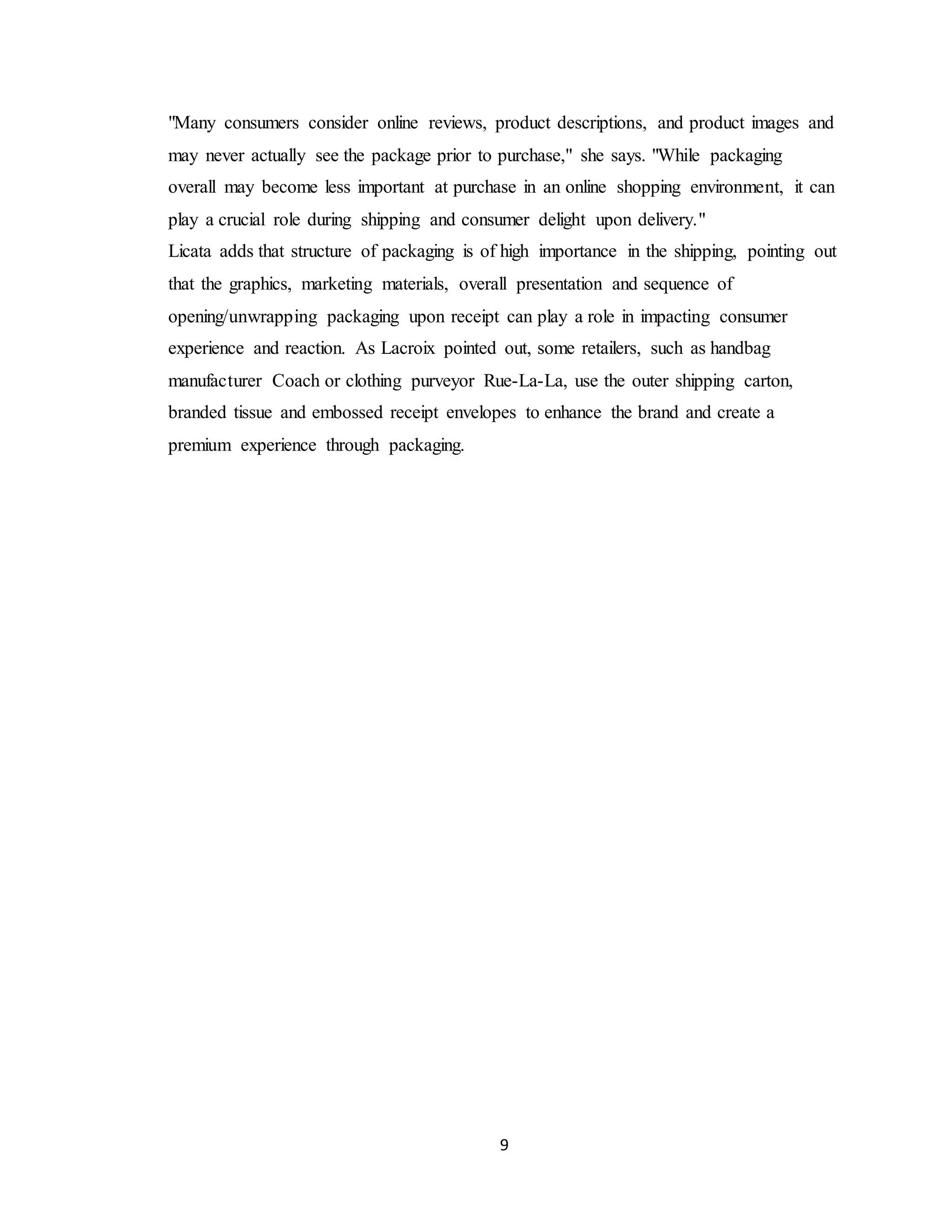
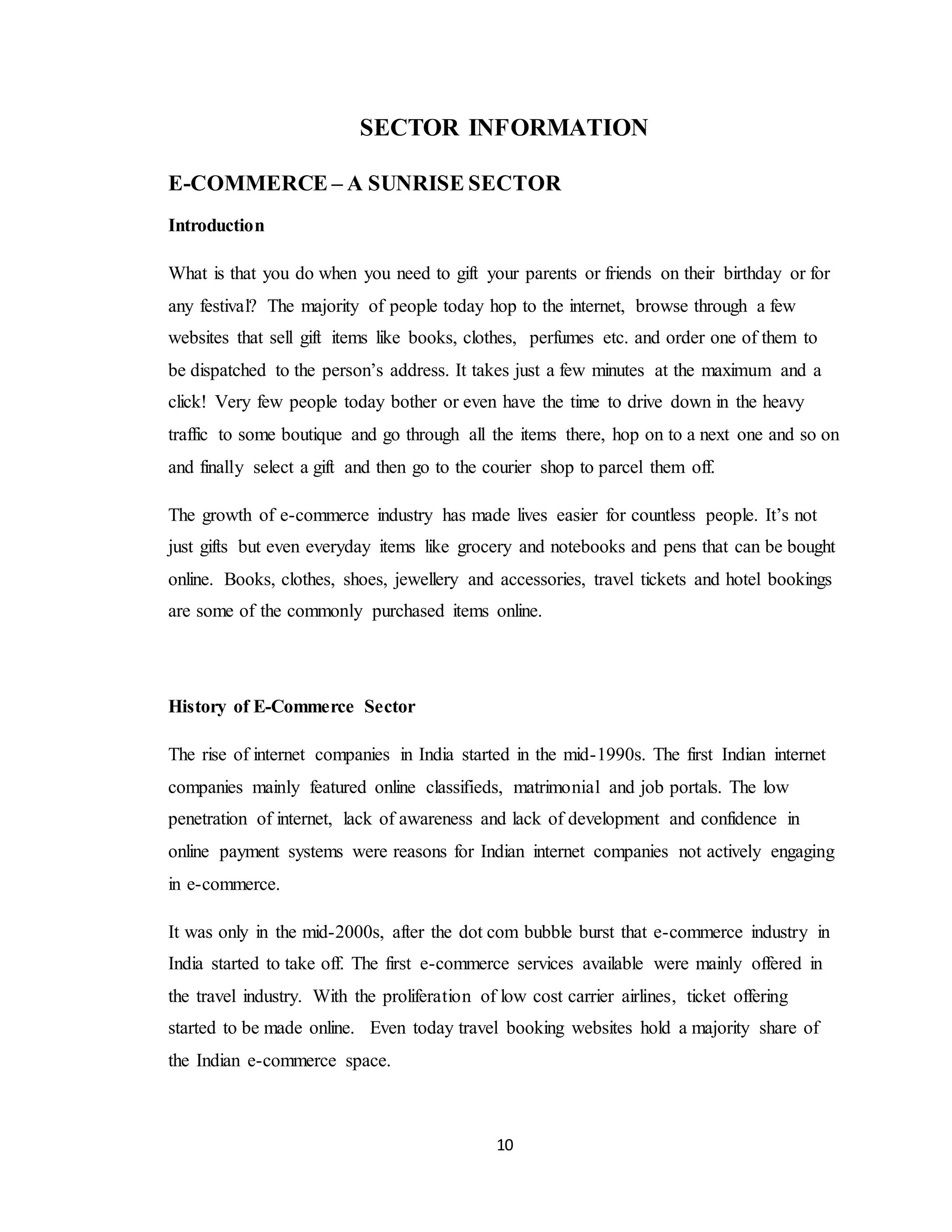
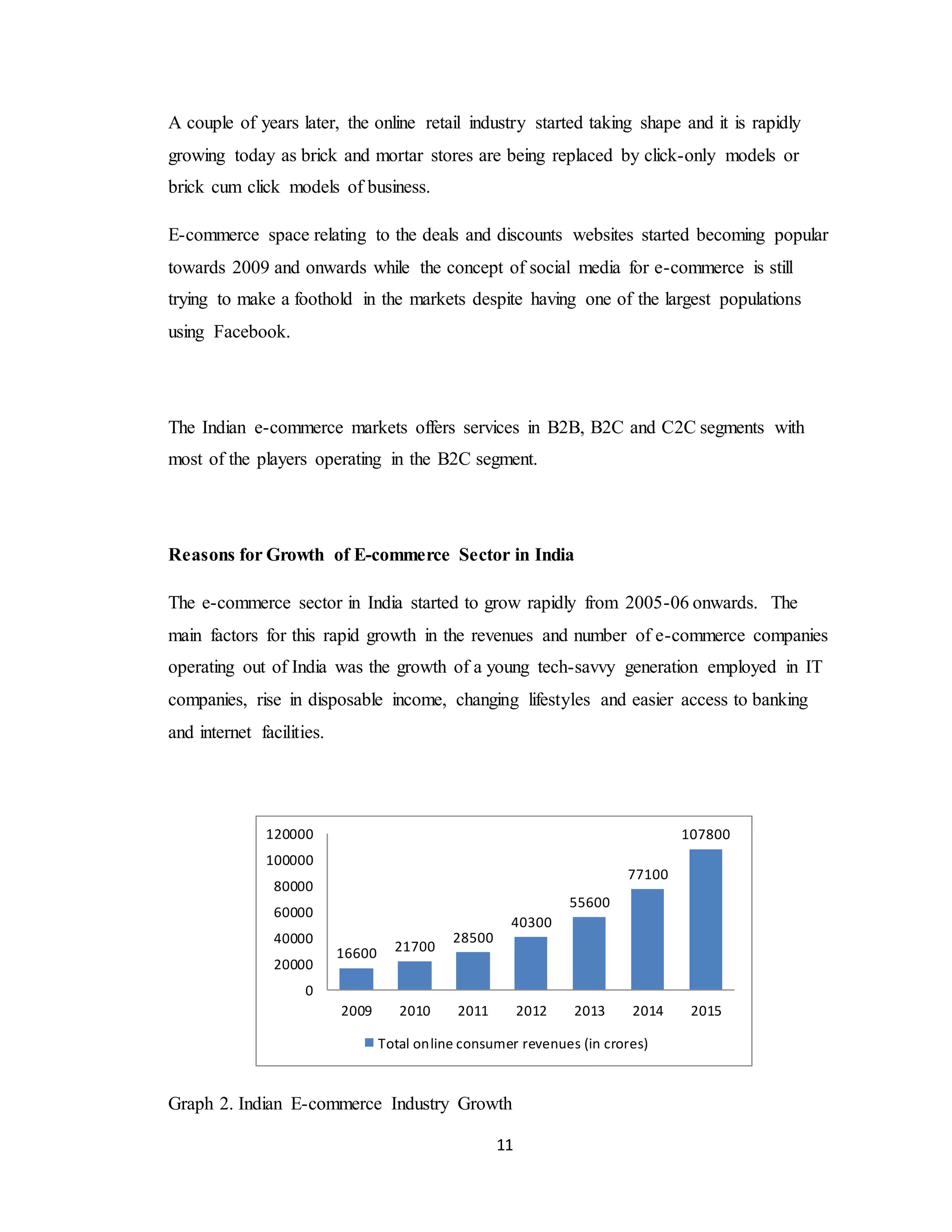

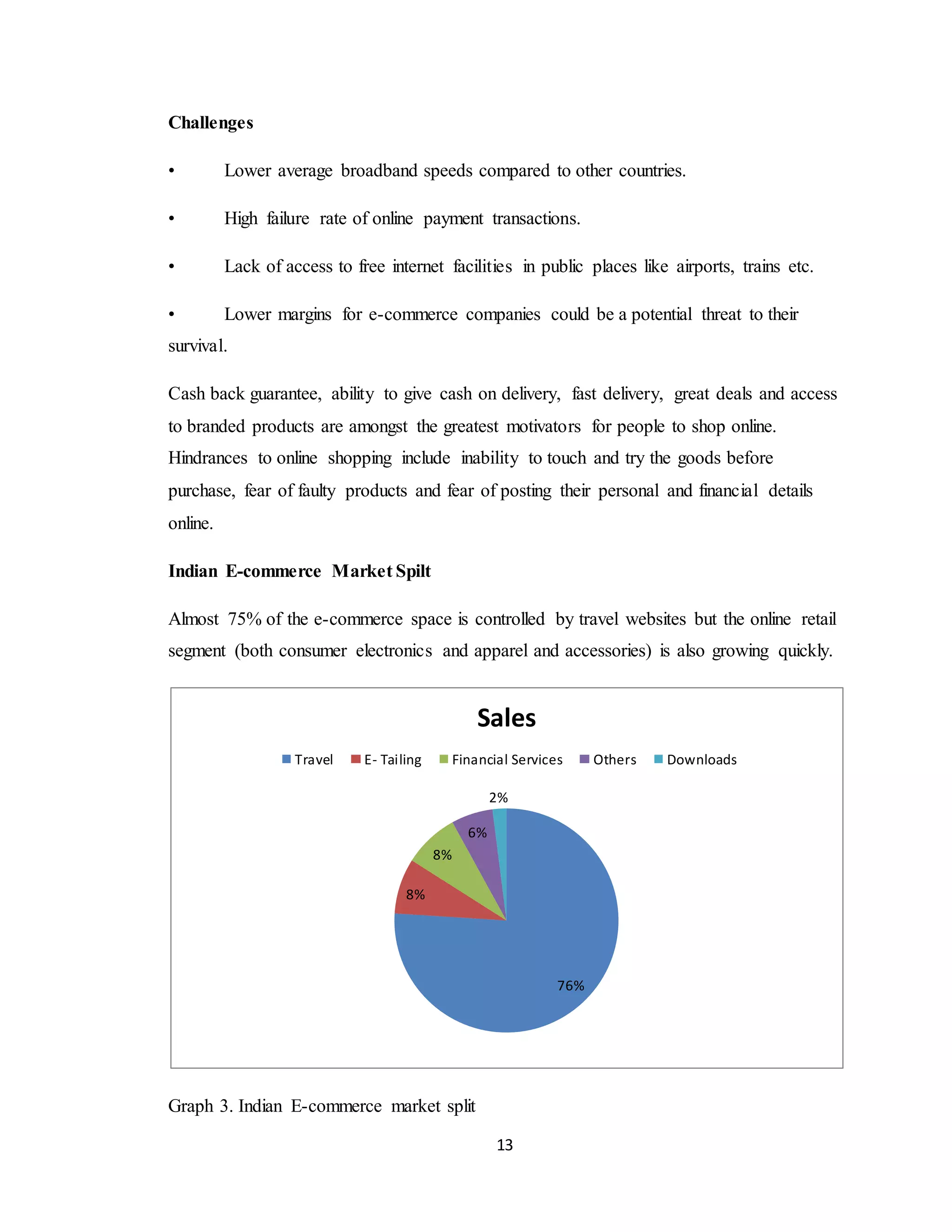
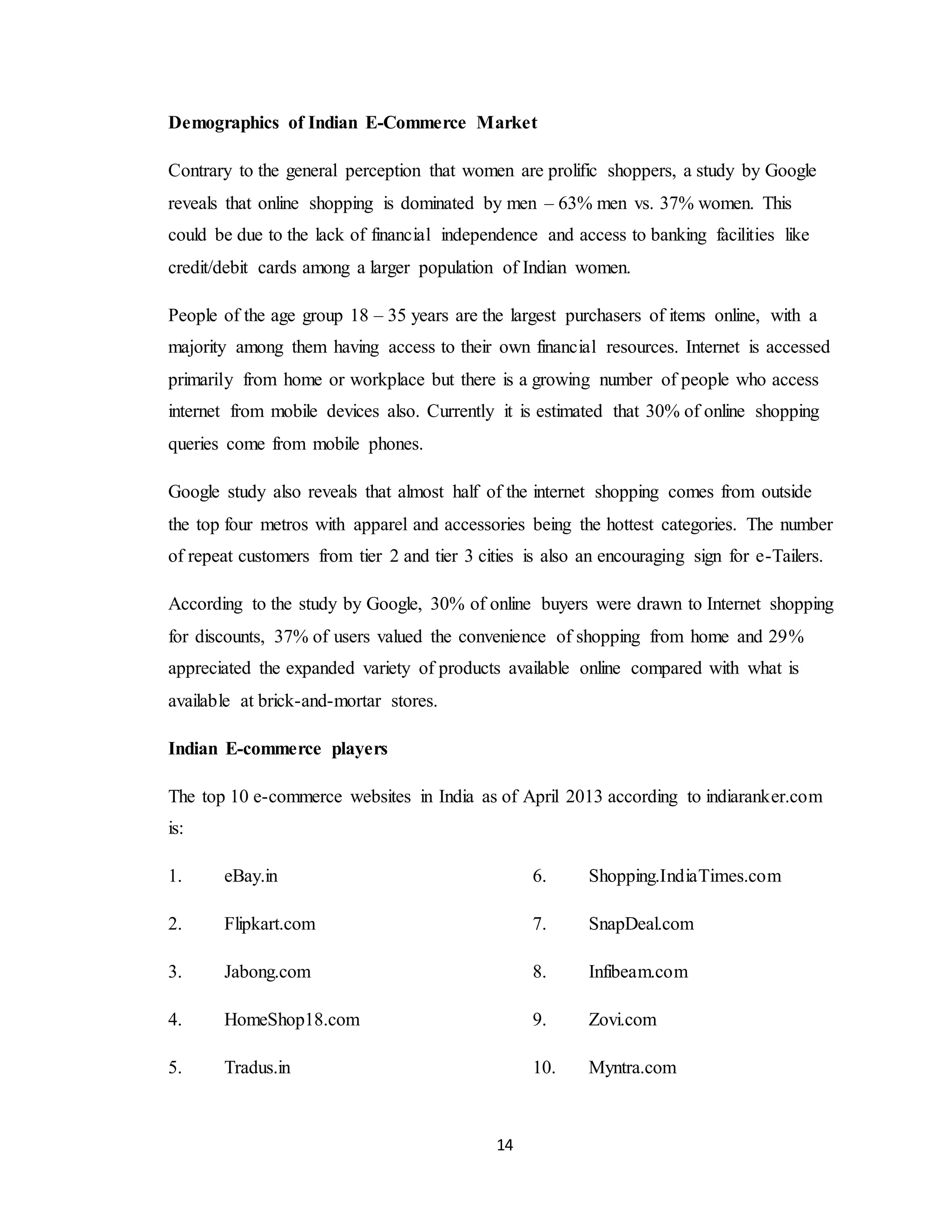
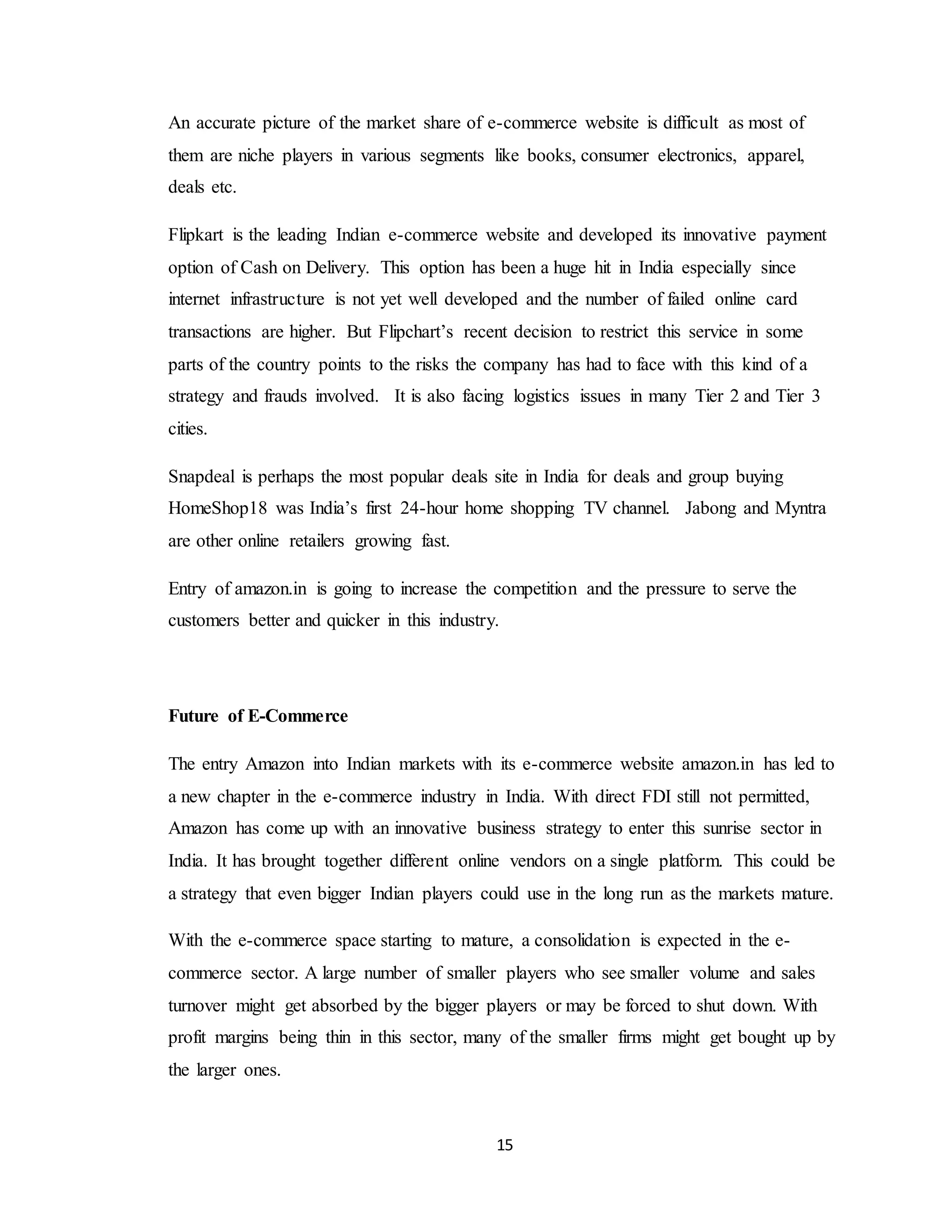

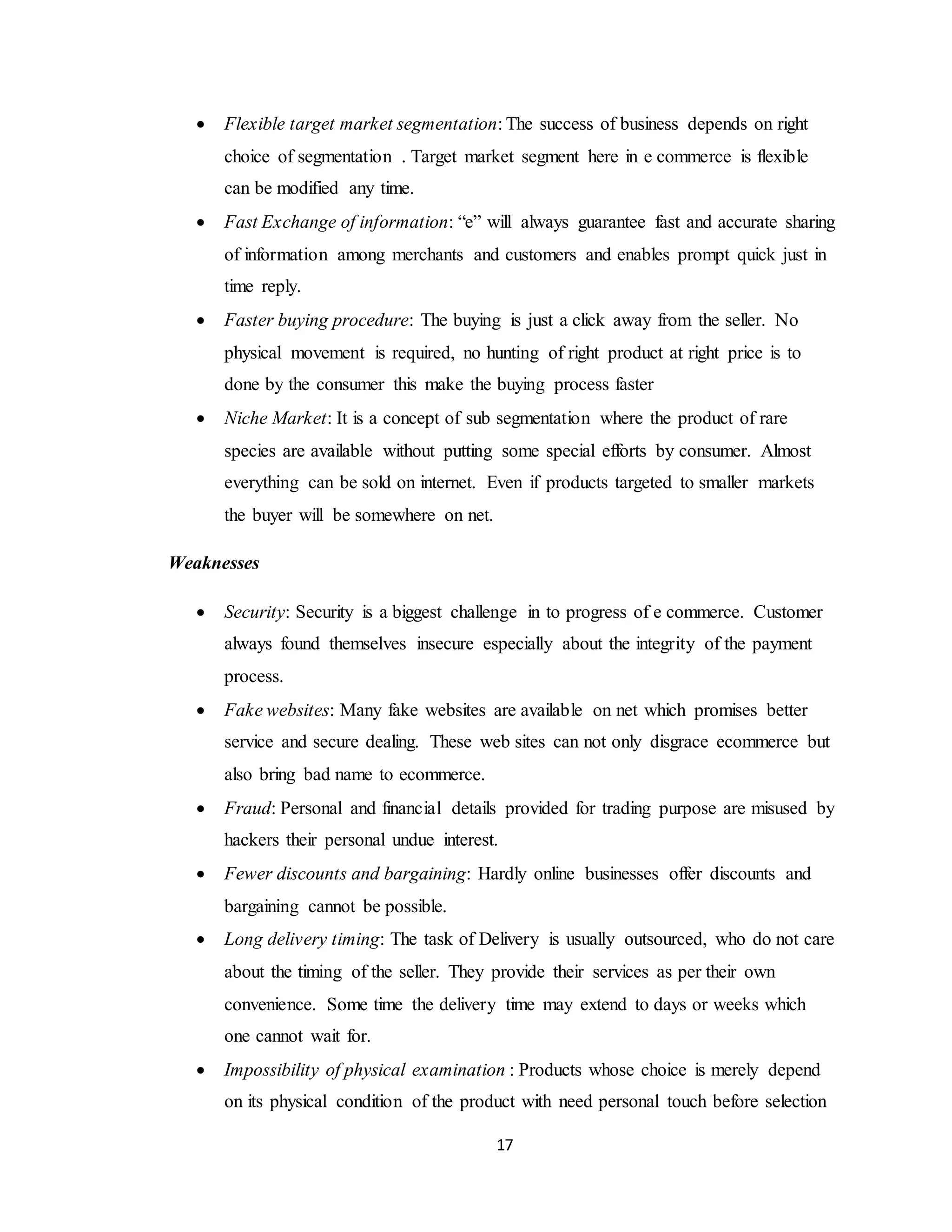
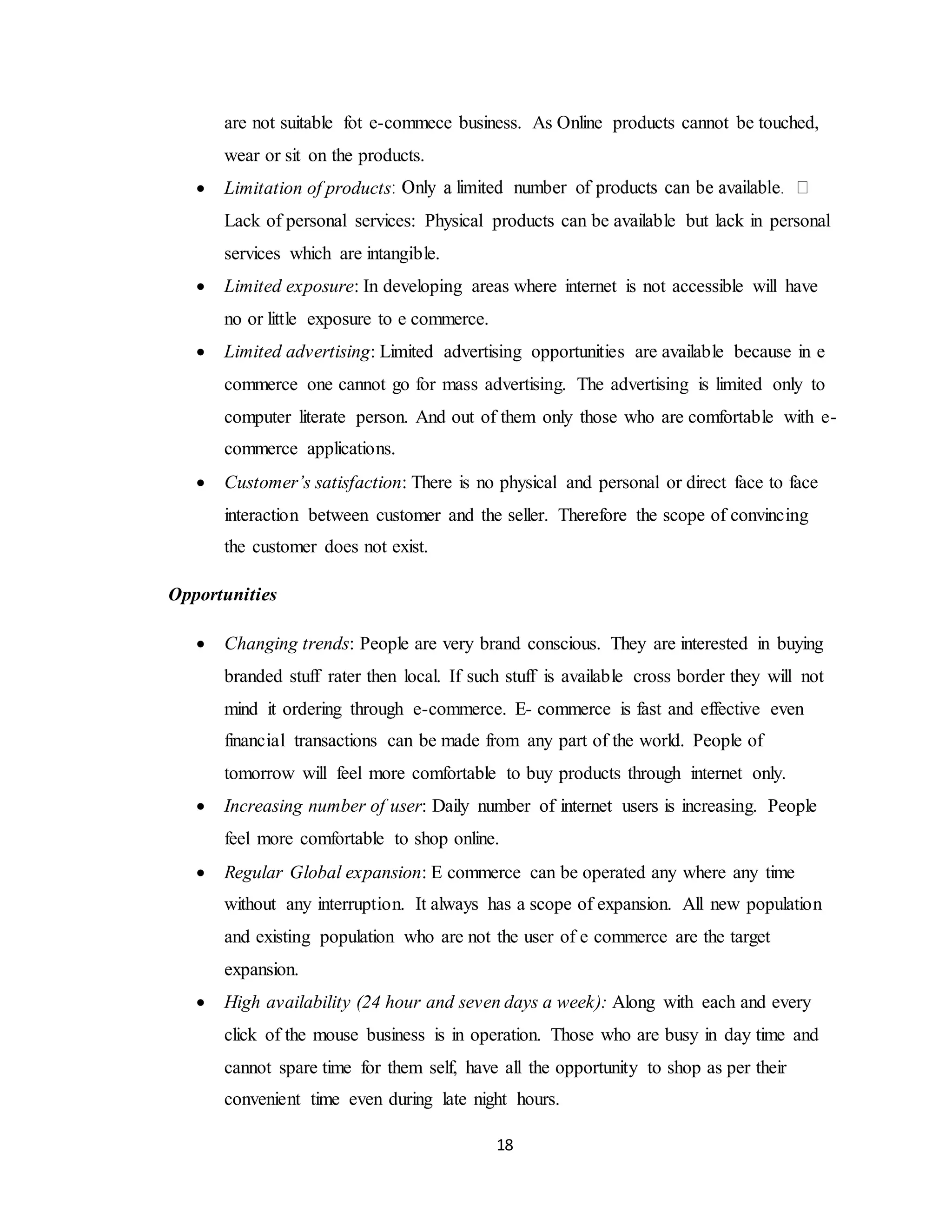
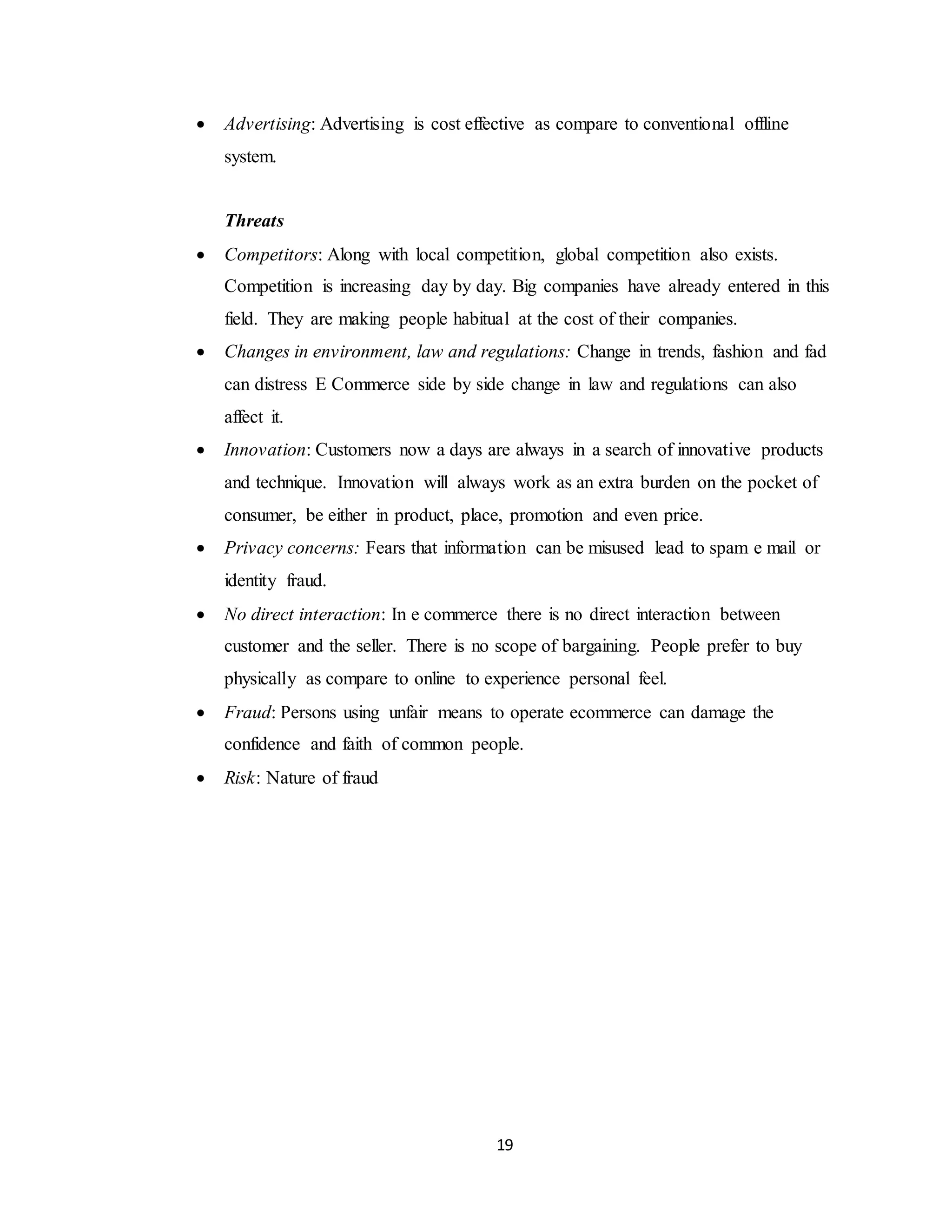
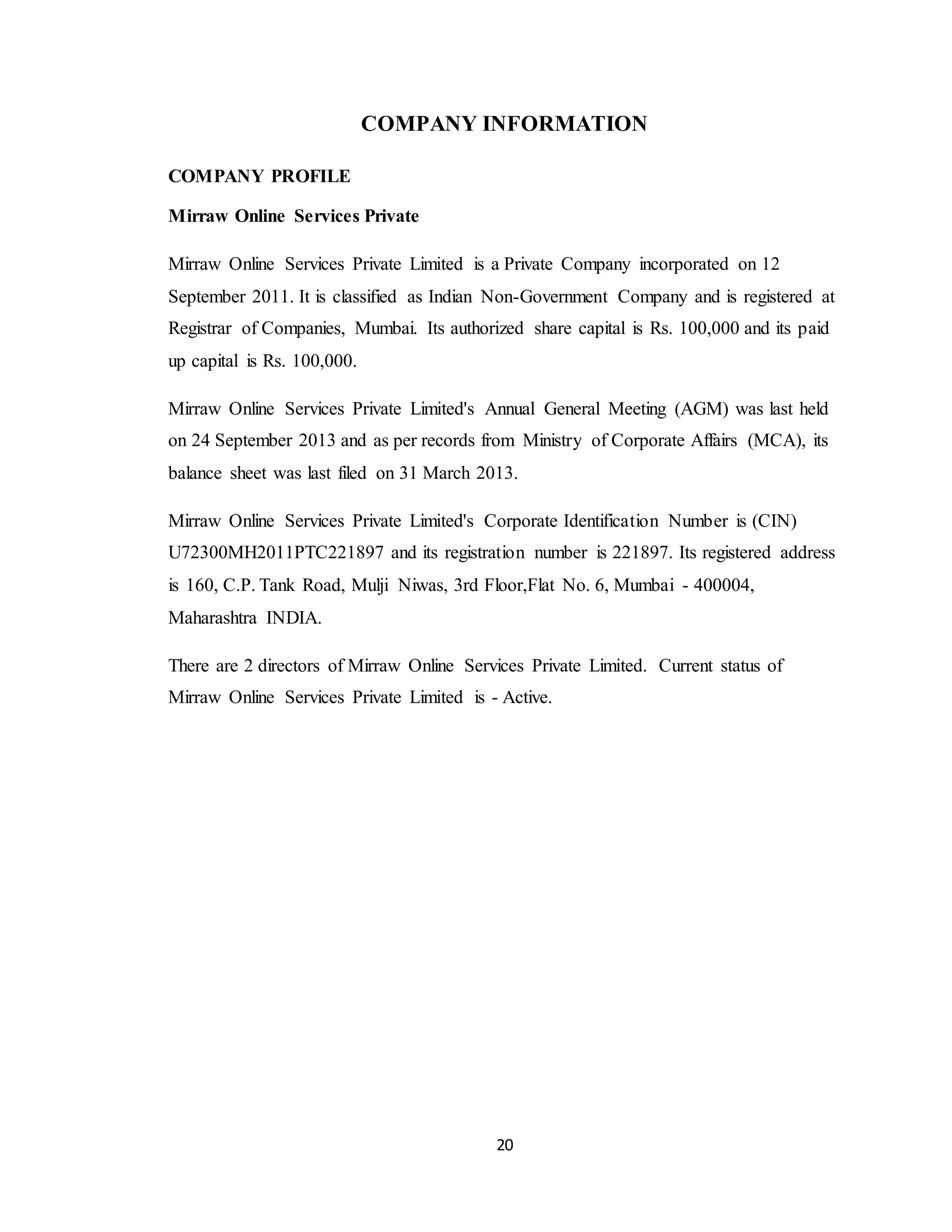
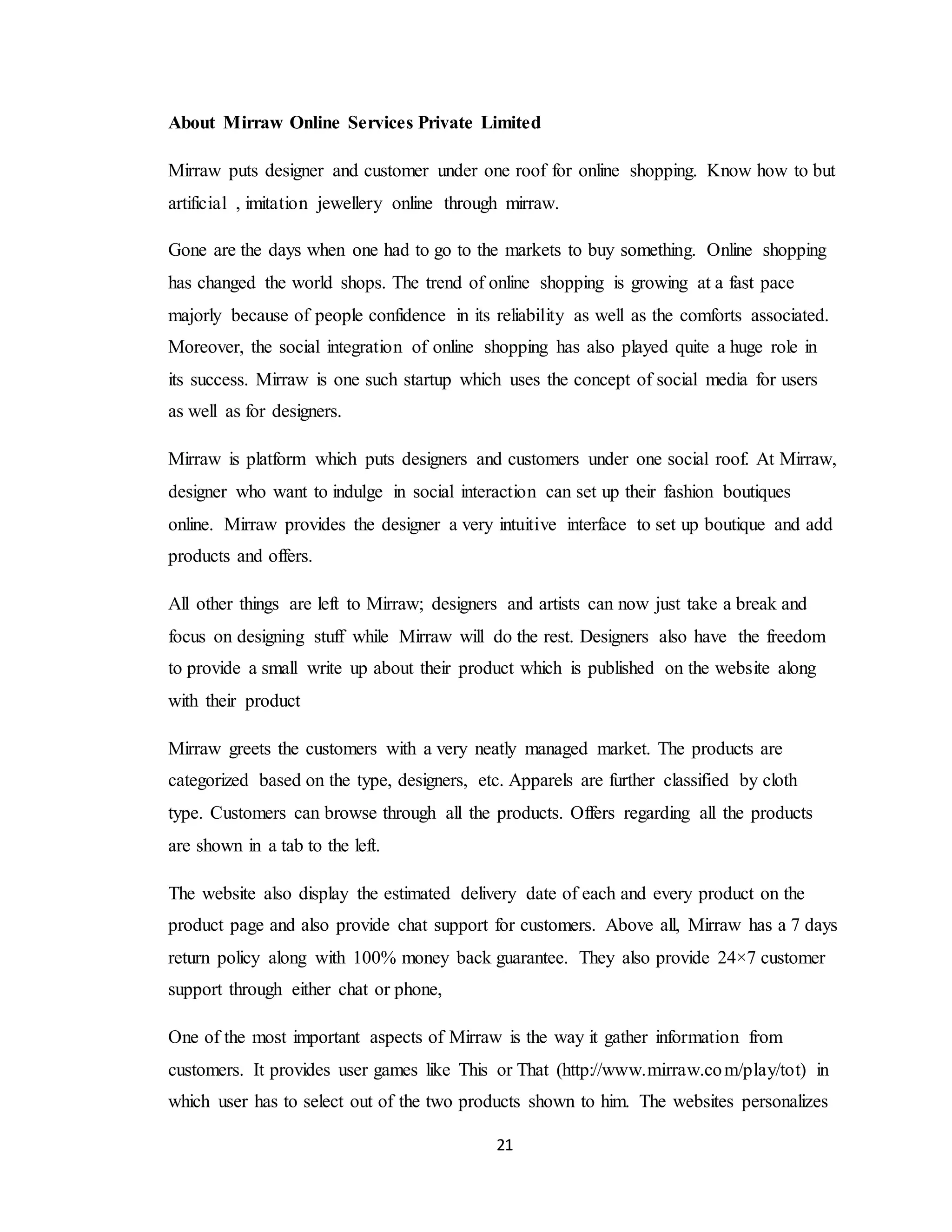

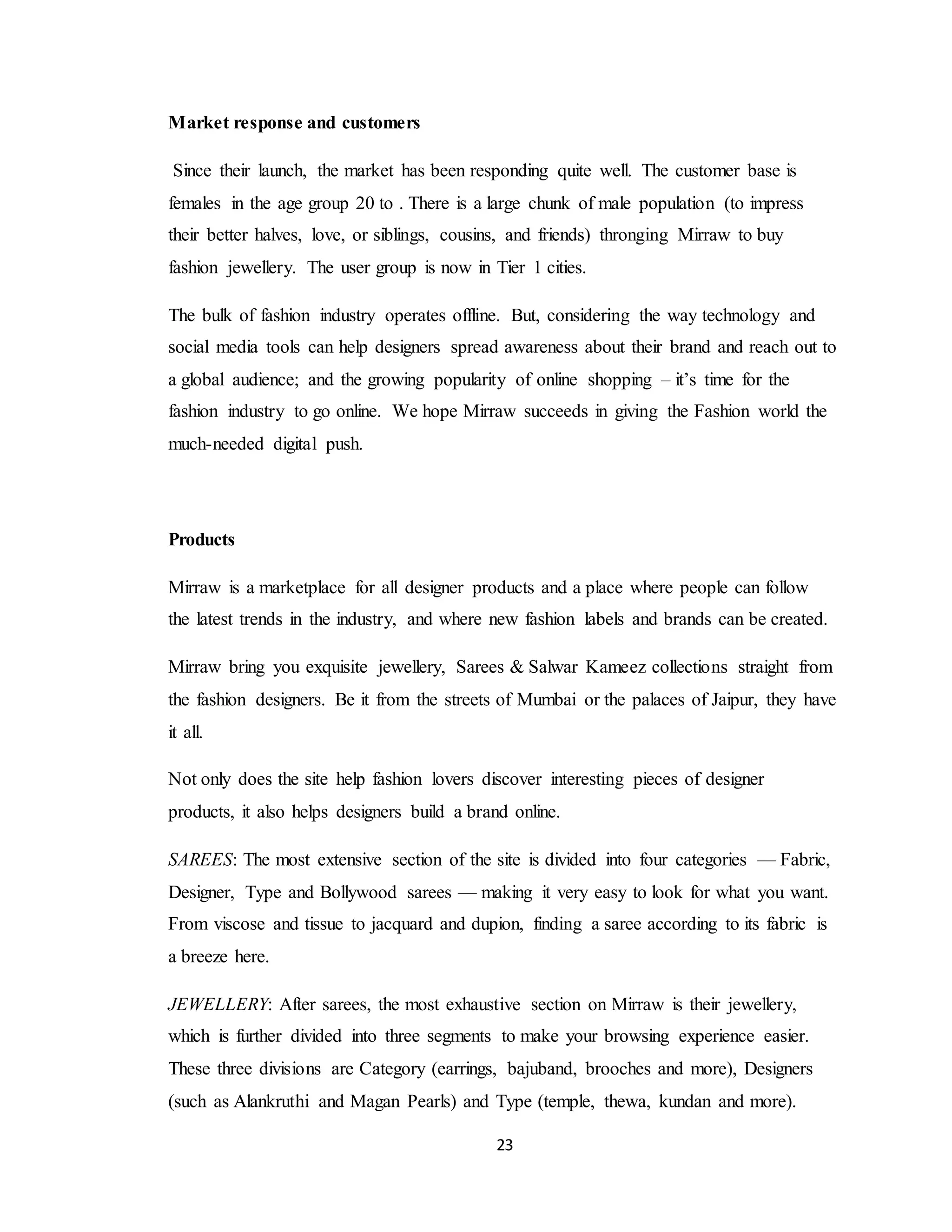
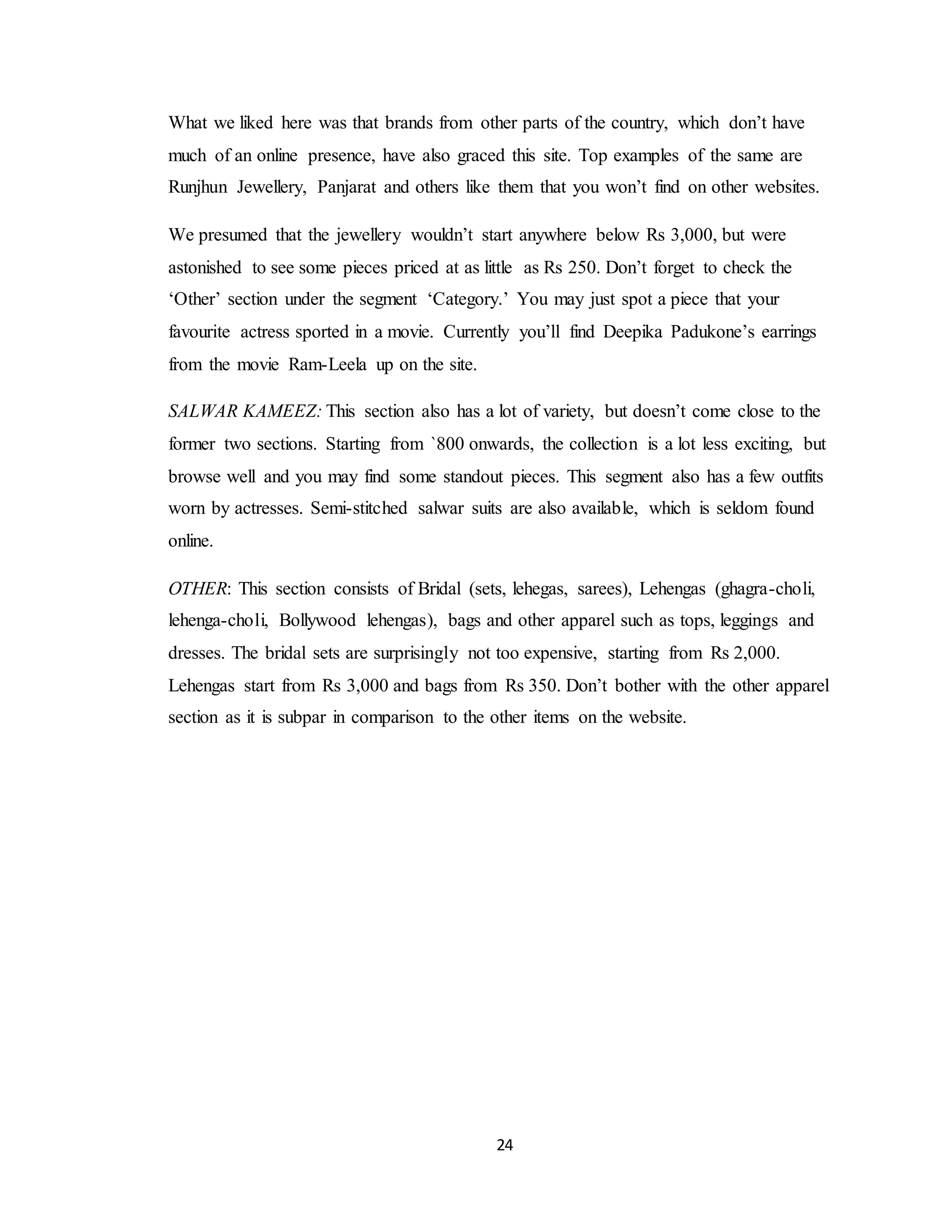

![26
Literature review
Packaging was defined by the European Federation
Visser (E. Packaging on the web: An underused resource. Design Management Journal,
winter, 62-67(2002)). as “all products made of any materials of any nature to be used for
the containment, protection, delivery and presentation of goods, from raw materials to
processed goods”.
Visser also indicated that it is difficult to translate the existing packaging design and
marketing tactics into online retailing. In his research he also found that information and
emotional components could not be seen on retailer’s web sites.
Nowadays, people have many choices when they want to buy a particular product, being
able to choose from dozens of similar products. As a consequence, it is quite hard to
make a decision. So, the manufacturers have to meet the customer’s needs in order to sell
their products. In this circumstance, packaging could be a powerful tool in the marketing
for the sales of the product. However, during online shopping, consumers cannot touch
products, nor can they see packaging well in cyberspace. So how can consumers be
persuaded by online packaging?
The physical packaging of products has been studied for several decades and has been
comprehensively understood.
The basic requirements of physical packaging include: containment, protection,
preservation, communication, handling and storage, as well as
convenience of use . The various functions of packaging can be divided into three
categories; primary, secondary and tertiary functions The primary functions concern the
structural nature of packaging. The secondary functions relate to the issues of visual
communication, with the tertiary functions being about the
additional values for the product.
Kathman [Kathman K. Brand Identity Development in the New Economy. Design Issue,
18(1), 25-35(2002).] states that the internet is a “highly self-select environment”, with a](https://image.slidesharecdn.com/d91a1d85-b869-4326-9092-d283d29bada5-160925124820/75/DATA-ANALYSIS-AND-INTERPRETATION-26-2048.jpg)
![27
new packaging design strategy that must be different from traditional thinking for gaining
a greater market share of e-commerce. Visual communication has always been used and
can be tracked back thousands of years. For example, traditional Chinese characters were
transferred from their hieroglyph into words, all the words were drawn into a similar
shape as “the thing” that it looked like.
Kellner [Kellner D. Critical perspectives on visual imagery in media and cyberculture.
Journal of Visual Literacy, 22(1), 81-90(2002).] pointed out that visual images are very
important for our life as they can help us understand and interpret complex constructions
simply. The visual or nonverbal information can be composed by fragmentary evidence
for the construction of assumption and interpretation [Nielsen J. Visual communication
and interaction. Digital Creativity].
Fiske J. Introduction to communication studies, 2nd ed., Routledge, London, (1990)
A addresser has to use signs to convey messages, in order to communicate with an
addressee, so that when an addresser communicates to an addressee, then the addressee
can understand the message on a certain level (more or less accurately). The level of
understanding depends on the message. The more signs the addressee knows, the greater
capacity for communication they have
Cosio M, Dyson M. Identifying graphic conventions for genre definition in web sites.
Digital Creativity, (13)3, 165-181(2002)
Cosio and Dyson also stated that addressees used their previous experiences to explain
the phenomena when they were faced a new or different circumstance.
Packaging is a good agent for any product, not only because of the text descriptions but
also for its visual communication. It can effectively deliver incisive product information,
brand identity and is also a good cognitive agent for recognition. However, what would
happen if packaging was applied to e-commerce? Would it play as well on the screen as it
does on a shelf? For e-commerce, these questions are important as online packaging](https://image.slidesharecdn.com/d91a1d85-b869-4326-9092-d283d29bada5-160925124820/75/DATA-ANALYSIS-AND-INTERPRETATION-27-2048.jpg)
![28
presentation could increase not only the number of visitors but also the number of e-
commerce purchases.
Elaboration Likelihood Model
Consumers would not be persuaded by the packaging if it failed to convey a suitable
message. Therefore it is important to understand consumers’ psychology, which in itself
can allow designers to design a more effective packaging for their target consumers.
There are many researchers who have developed models of the dual process of
persuasion and influence on people. These models were recognised as the Hierarchy-of-
Effects Models (HEM). The first HEM was formulated by Lavidge and Steinger in 1961
[Lien NH. Elaboration Likelihood Model in Consumer Research: A Review. National
Science Council,
Taiwan, (11)4, 301-310(2001)]with two further models, the ELM by Richard Petty and
John Cacioppo and the other Heuristic Systematic Model by Shelly Chaiken [24] being
more widely used. However, the ELM is more frequently applied and cited in many
disciplines of research for both cognitive psychology and consumer research. Moreover,
it has obtained appreciable attention in research results and theoretical debates.
The ELM of persuasion is a model about how people get influenced when they receive
information. Petty and Cacioppo stated that there are two routes to process when people
receive information from a third party. The two routes are the central route and the
peripheral route. The central route is a method to process information, which means that
if a person had the ability and motive to process information he/she would more than
likely adopt this route. In contrast he/she would adopt the peripheral route. Additionally
the central route (known as high involvement) can be considered as a systematic method,
with the peripheral route (known as low involvement) being considered as a heuristic
method to the processing of information. Importantly, the ELM is used to measure the
effectiveness of commercial advertising. Much research has been conducted on this
theme From another angle, it seems that online packaging can be treated as an
advertisement for a product. Advertising campaigns sometimes link packaging and](https://image.slidesharecdn.com/d91a1d85-b869-4326-9092-d283d29bada5-160925124820/75/DATA-ANALYSIS-AND-INTERPRETATION-28-2048.jpg)
![29
advertising together, even though they both promote the product, reinforce the brand
image and attract the consumers’ attention. However some aspects allow us to recognize
subtle differences between them. Kotler, et al [34] indicated that there are more than
15000 items in an average supermarket with 53% of customers shopping impulsively,
packaging being one of the main factors in achieving this figure.
Reiner T, Rose D. Packaging design VS. conventional advertising, Austropack, July
(2002), accessed: 18/04/03
Reiner and Rose provides us with three points to distinguish the difference between
advertising and packaging
1) 70% of impulse shopping without remembering advertising but packaging.
2) A product’s packaging of a product advertises the product before and after purchase.
3) The packaging of a product has a longer shelf life than the life of the product’s
advertisement.
Visser also mentioned that packaging is not only the skin of a product to help to
communicate with the consumers but that it is also a mirror to reflect the soul of product.
Therefore the authors considered that online packaging should be able to do the same job
as it would do in the real shop environment, and even more importantly it is thought that
online packaging could not be replaced by online advertising. Although online packaging
has not been deeply studied, the above researches could offer good references for future
research.](https://image.slidesharecdn.com/d91a1d85-b869-4326-9092-d283d29bada5-160925124820/75/DATA-ANALYSIS-AND-INTERPRETATION-29-2048.jpg)


